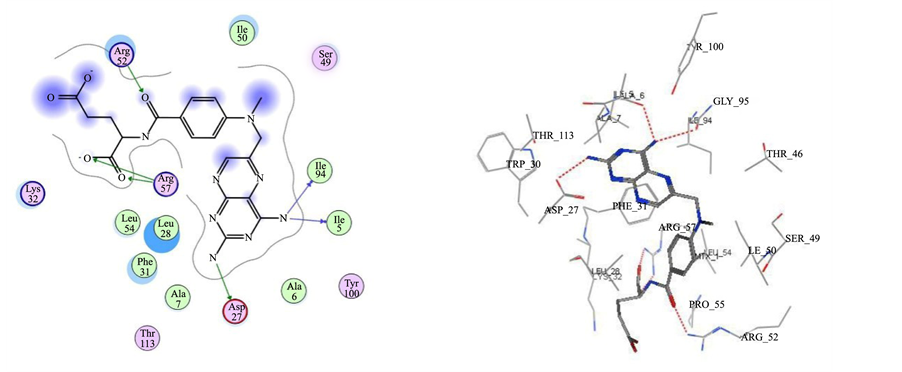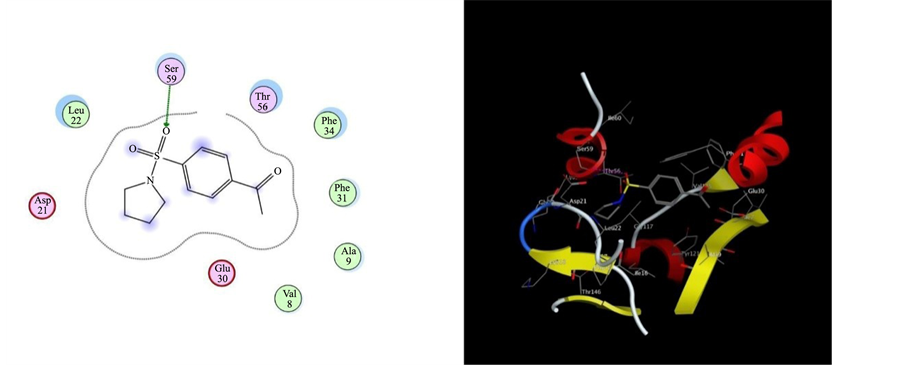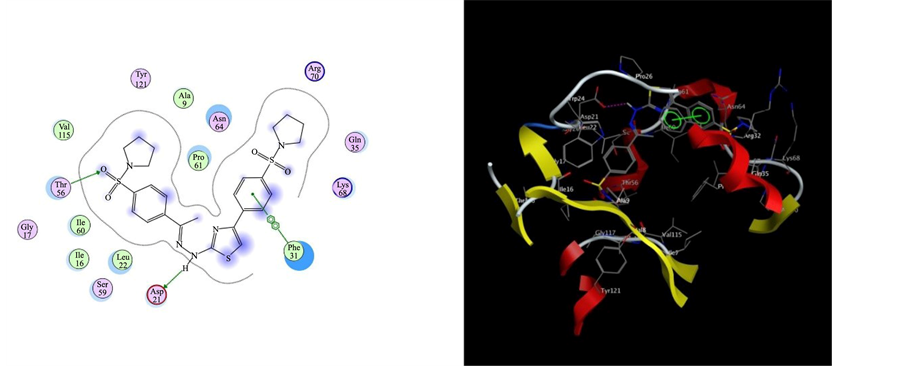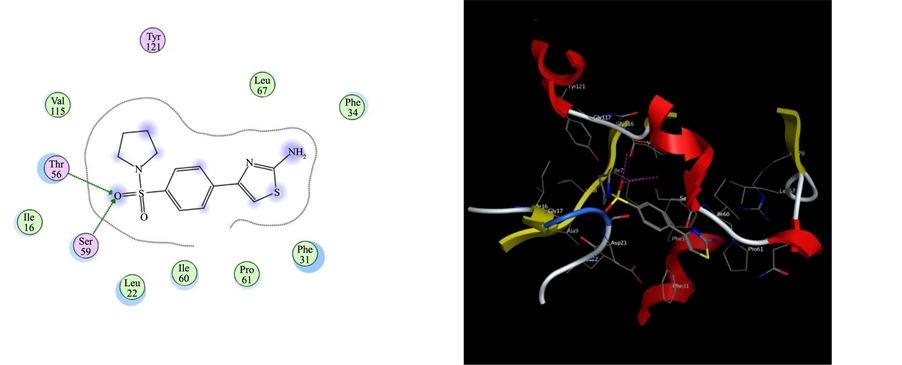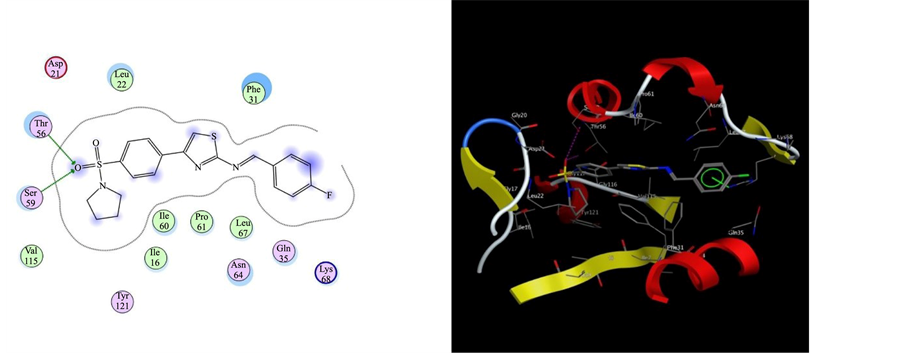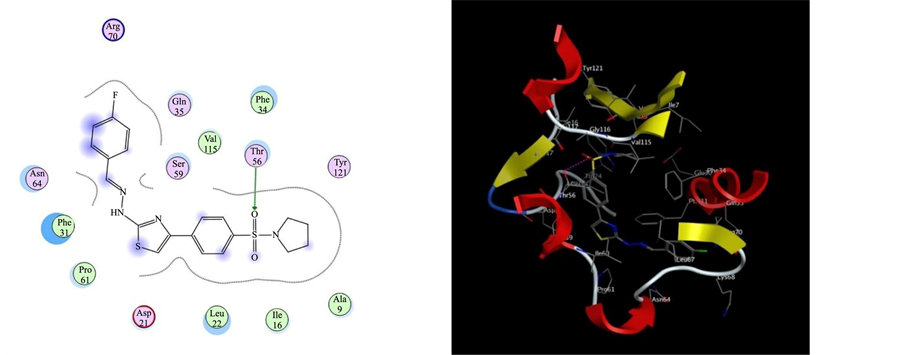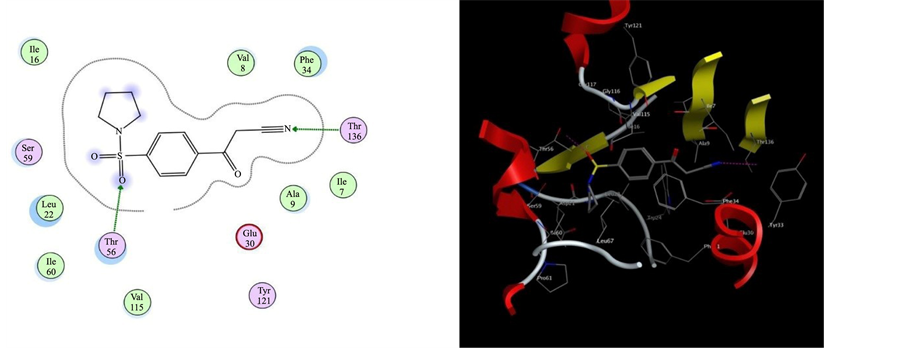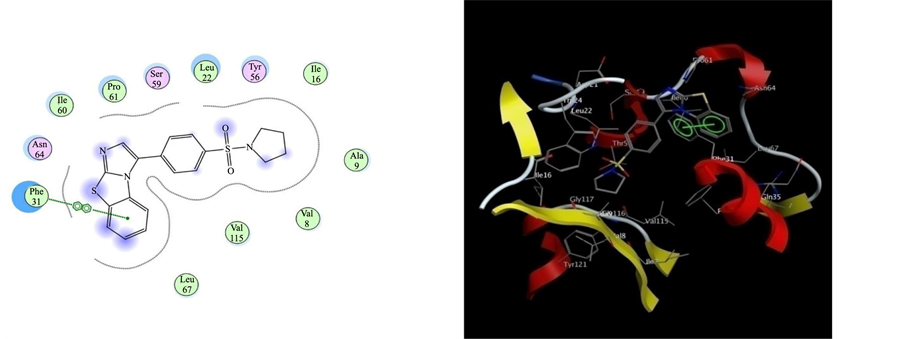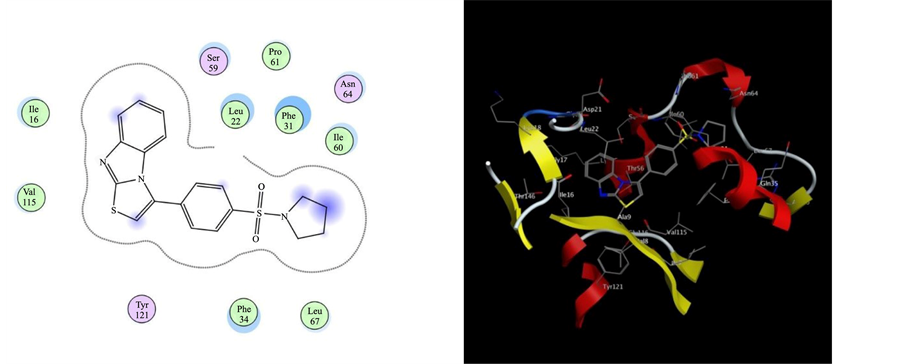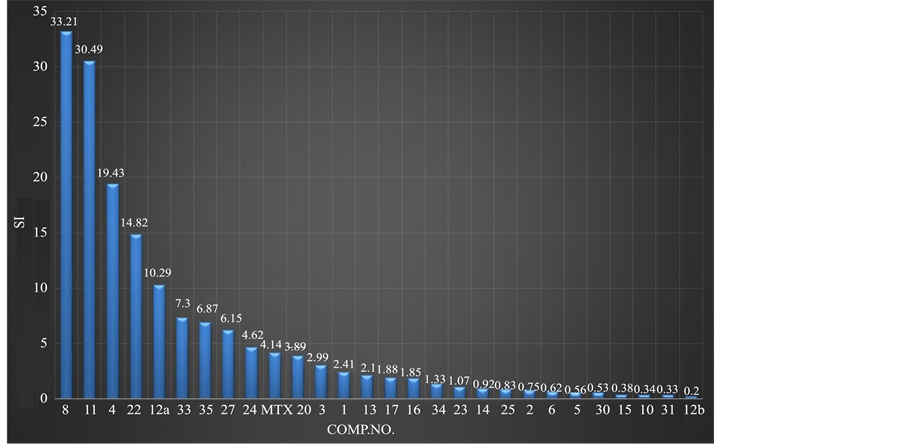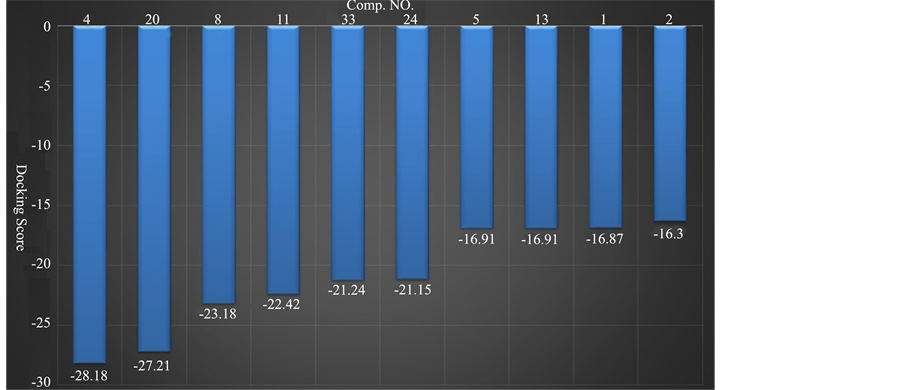International Journal of Organic Chemistry
Vol.05 No.03(2015), Article ID:59456,24 pages
10.4236/ijoc.2015.53018
1-(4-(Pyrrolidin-1-ylsulfonyl)phenyl) ethanone in Heterocyclic Synthesis: Synthesis, Molecular Docking and Anti-Human Liver Cancer Evaluation of Novel Sulfonamides Incorporating Thiazole, Imidazo[1,2-a]pyridine, Imidazo[2,1-c] [1,2,4]triazole, Imidazo[2,1-b]thiazole, 1,3,4-Thiadiazine and 1,4-Thiazine Moieties
Mahmoud Sayed Bashandy
Chemistry Department, Faculty of Science (Boys), Al-Azhar University, Nasr City, Cairo, Egypt
Email: bashandy_sci@yahoo.com
Copyright © 2015 by author and Scientific Research Publishing Inc.
This work is licensed under the Creative Commons Attribution International License (CC BY).
http: //creativecommons.org/licenses/by/4.0/



Received 14 June 2015; accepted 5 September 2015; published 8 September 2015
ABSTRACT
This article describes the synthesis of some novel sulfonamides having the biologically active, thiazole 4-6, 8, 10-12a,b, 20, 22, 34, 35, imidazo[1,2-a]pyridine 14, imidazo[2,1-c][1,2,4]triazole 15, imidazo[2,1-b]thiazole 23, 24, 33, nicotinonitrile 25, 1,3,4-thiadiazine 27, quinoxaline 30 and 1,4- thiazine 31 moieties, starting with 1-(4-(pyrrolidin-1-ylsulfonyl)phenyl)ethanone (1). The structures of the newly synthesized compounds were confirmed by elemental analysis, IR, 1H NMR, 13C NMR and Ms spectral data. All the compounds were tested in-vitro antihuman liver hepatocellular carcinoma cell line (HepG2). Compounds 8, 11, 4, 22, 12a, 33, 35, 27 and 24 with selectivity index (SI) values of 33.21, 30.49, 19.43, 14.82, 10.29, 7.3, 6.87, 6.15 and 4.62, respectively, exhibited better activity than methotrexate (MTX) as a reference drug with SI value of 4.14. Molecular Operating Environment (MOE) performed virtual screening using molecular docking studies of the synthesized compounds. The results indicated that some synthesized compounds are suitable inhibitors against dihydrofolate reductase (DHFR) enzyme (PDB ID: 4DFR) with further modification.
Keywords:
Benzenesulfonamide, Pyrrolidine, Thiazole, Anti-Human Liver Cancer, Molecular Docking

1. Introduction
Sulfonamides have been demonstrated to possess antibacterial [1] -[3] , antifungal [4] , insulin-releasing [5] [6] , carbonic anhydrase inhibitory [7] -[9] , hypoglycemic [10] , anesthetic [11] , anti-inflammatory [12] [13] , andanti- carcinogenic [14] [15] activities. Liver cancer (hepatocellular carcinoma) remains one of the most important health problems in the world because it is the third foremost cause of cancer-related deaths worldwide [16] . In view of these reports and as a continuation of previous works [17] -[21] directed towards the synthesis of substituted heterocycles, incorporating benzenesulfonamide with anticipated biological activities, therefore, this article reports new and convenient methods for the synthesis of heterocyclic ring systems that are required to medicinal chemistry utilizing 1-(4-(pyrrolidin-1-ylsulfonyl)phenyl)ethanone (1) as a starting material. Since, the carbonyl and the methyl functions of compound 1 suitably situated to enable reaction with common bi-dentate reagents to form a variety of heterocyclic compounds having sulfonamide function, and investigated their anti- human liver cancer activities.
2. Material and Methods
2.1. Experimental
Melting points (˚C, uncorrected) were determined in open capillaries on a Gallen Kemp melting point apparatus (Sanyo Gallen Kemp, Southborough, UK). IR spectra (KBr) were recorded on FT-IR 5300 spectrometer and Perkin Elmer spectrum RXIFT-IR system (ν, cm−1). Pre-coated silica gel plates (silica gel 0.25 mm, 60 G F 254; Merck, Germany) were used for thin layer chromatography. The NMR spectra in (DMSO-d6) were recorded at 300 MHz on a Varian Gemini NMR spectrometer (δ, ppm). Mass spectra were obtained on GC Ms-QP 1000 EX mass spectrometer at 70 ev. Elemental analyses were performed on Carlo Erba 1108 Elemental Analyzer (Heraeus, Hanau, Germany). All compounds were within ± 0.4% of the theoretical values. Analyses were carried out by the Micro analytical Research Center, Faculty of Science, Cairo University and Al-Azhar University. 1-(4-(Pyrrolidin-1-ylsulfonyl)phenyl)ethanone (1) was prepared according to the procedures reported in the literature [22] . Yellowish white crystals, Yield, 83%; mp 115˚C - 116˚C (ethanol). IR (KBr, cm−1): vmax = 3070 (CH aromatic), 2973 (CH aliphatic), 1696 (C=O), 1347, 1153 (SO2). 1H NMR (DMSO-d6): δ = 1.87 (t, 4H, CH2-CH2 pyrrolidine), 2.55 (s, 3H, CH3), 3.25 (t, 4H, CH2-N-CH2 pyrrolidine), 7.65, 8.26 (dd, 4H, Ar-H, AB system, J = 9.41 Hz). 13C NMR (DMSO-d6): δ = 24.7 (2C, CH2-CH2 pyrrolidine), 28.3 (CH3), 63.1 (2C, CH2- N-CH2 pyrrolidine), [125.6 (2C), 130.2 (2C), 141.4, 145.2] (6ArC's), 199.3 (C=O). MS m/z (%): 253.11 [M+] (9.07), 183.02 (6.98), 174.09 (4.39), 119.06 (19.80), 104.05 (7.35), 91.09 (11.94), 76.06 (14.71), 70.08 (100.00), 43.08 (36.05). Anal. Calcd. for C12H15NO3S (253.32): C, 56.90; H, 5.97; N, 5.53; S, 12.66. Found: C, 56.88; H, 5.94; N, 5.61; S, 12.53%.
2.1.1. 2-Bromo-1-(4-(pyrrolidin-1-ylsulfonyl)phenyl)ethanone (2)
To a stirred solution of 1-(4-(pyrrolidin-1-ylsulfonyl)phenyl)ethanone (1; 2.53 g, 0.01 mol) in dioxane/diethyl- lether mixture (1:2) (30 mL), the bromine (1.59g, 0.01 mol) was added drop wise with constant stirring.After complete addition, the reaction will left for 1 h, then the reaction mixture poured in cold water (100 mL), the separated solid was filtered off and recrystallized from ethanol to give 2. White crystals, Yield, 90%; mp 96˚C - 98˚C. IR (KBr, cm−1): vmax = 3056 (CH aromatic), 2909 (CH aliphatic), 1707 (C=O), 1336, 1161 (SO2). 1H NMR (DMSO-d6): δ = 1.99 (t, 4H, CH2-CH2 pyrrolidine), 3.27 (t, 4H, CH2-N-CH2 pyrrolidine), 4.56 (s, 2H, CH2), 7.84, 8.22 (dd, 4H, Ar-H, AB system, J = 8.57 Hz). 13C NMR (DMSO-d6): δ = 22.1 (2C, CH2-CH2 pyrrolidine), 32.7 (CH2), 64.2 (2C, CH2-N-CH2 pyrrolidine), [123.0 (2C), 128.8 (2C), 134.0, 143.0] (6ArC's), 193.5 (C=O). MS m/z (%): 333.03 [M++2] (1.59), 332.02 [M++1] (1.58), 331.03 [M+] (1.92), 330.02 (1.06), 238.07 (15.70), 196.98 (3.49), 174.10 (22.39), 118.10 (10.24), 116.07 (18.07), 104.06 (14.23), 90.08 (10.25), 89.07 (14.76), 70.09 (100.00), 63.05 (5.49), 42.06 (54.43). Anal. Calcd. for C12H14BrNO3S (332.21): C, 43.38; H, 4.25; N, 4.22; S, 9.65. Found: C, 43.41; H, 4.10; N, 4.16; S, 9.71%.
2.1.2. 2-(1-(4-(Pyrrolidin-1-ylsulfonyl)phenyl)ethylidene)hydrazinecarbothioamide (3)
A mixture of acetophenone derivative 1 (2.53 g, 0.01 mol) and thiosemicarbazide (0.91 g, 0.01 mol) in ethanol (50 mL) was heated under reflux for 5 h, during the reflux period, a pale yellow crystalline solid was separated. The separated solid was filtered off, washed with ethanol, dried and recrystallized from ethanol/benzene to give 3. White crystals, Yield, 53%; mp 130˚C - 131˚C. IR (KBr, cm−1): vmax = 3414, 3310 (NH2), 3198 (NH), 3077 (CH aromatic), 2956 (CH aliphatic), 1587 (C=N), 1345, 1165 (SO2), 1280 (C=S). 1H NMR (DMSO-d6): δ = 1.83 (t, 4H, CH2-CH2 pyrrolidine), 2.32 (s, 3H, CH3), 3.29 (t, 4H, CH2-N-CH2 pyrrolidine), 6.40 (br, 2H, NH2 exchangeable with D2O), 7.70, 8.11 (dd, 4H, Ar-H, AB system, J = 8.72 Hz), 8.90 (br, 1H, NH exchangeable with D2O). MS m/z (%): 326.34 [M+] (0.13), 307.12 (1.25), 226.09 (11.06), 183.05 (12.49), 119.10 (17.22), 101.17 (21.02), 86.13 (100.00), 80.02 (6.74), 72.14 (6.44), 58.10 (73.45). Anal. Calcd. for C13H18N4O2S2 (326.44): C, 47.83; H, 5.56; N, 17.16; S, 19.65. Found: C, 47.76; H, 5.42; N, 17.22; S, 19.59%.
2.1.3. 4-(4-(Pyrrolidin-1-ylsulfonyl)phenyl)-2-(2-(1-(4-(pyrrolidin-1-ylsulfonyl)phenyl)- ethylidene)hydrazinyl)thiazole (4)
A mixture of thiocarbamoyl derivative 3 (3.26g, 0.01 mol), phenacyl bromide derivative 2 (3.32 g, 0.01 mol) and fused sodium acetate (6.56 g, 0.08 mol) in ethanol (50 mL) was heated under reflux for 4 h, during the reflux period, a yellow crystalline solid was separated. The separated solid was filtered off, washed with ethanol, dried and recrystallized from dioxane to give 4. Yellow crystals, Yield, 42%; mp 170˚C - 171˚C. IR (KBr, cm−1): vmax = 3263 (NH), 3098 (CH aromatic), 2970 (CH aliphatic), 1588 (C=N), 1356, 1172 (SO2). 1H NMR (DMSO-d6): δ = 1.93 (t, 8H, 2CH2-CH2 pyrrolidine), 2.51 (s, 3H, CH3), 2.80 (t, 8H, 2CH2-N-CH2 pyrrolidine), 7.28 (s, 1H, CH-thiazole), 7.92-8.11 (m, 8H, Ar-H), 8.87 (s, 1H, NH exchangeable with D2O). MS m/z (%): 559.47 [M+] (0.81), 305.08 (23.78), 291.99 (9.32), 268.11 (19.98), 251.06 (7.89), 199.05 (74.82), 140.05 (100.00), 135.05 (12.84), 91.07 (82.77), 77.05 (79.36). Anal. Calcd. for C25H29N5O4S3 (559.72): C, 53.65; H, 5.22; N, 12.51; S, 17.19. Found: C, 53.59; H, 5.08; N, 12.34; S, 17.25%.
2.1.4. 4-(4-(Pyrrolidin-1-ylsulfonyl)phenyl)thiazol-2-amine (5)
1) Procedure (A)
Thiourea (1.52 g, 0.02 mole) and I2 (2.53 g, 0.01 mole) were triturated and mixed with acetophenone derivative 1 (2.53 g, 0.01 mol) in dioxane (40 mL). The mixture was refluxed with occasional stirring for 8 h. The obtained solid was washed with aqueous sodium thiosulfate to remove excess iodine and then with water. The crude product was dissolved in hot water, filtered to remove the sulphone, and 2-aminothiazole derivative 5 was precipitated by addition of NH3, H2O. The crude product was dried and recrystallized from dioxane to give 5, (yield 23%).
2) Procedure (B)
A solution of phenacyl bromide derivative 2 (3.32 g, 0.01 mol) and thiourea (0.76 g, 0.01 mole) in ethanol (40 mL) was refluxed for 2 h. After addition of pyridine (5 mL) and continued reflux for 5 h, the solvent was removed in vacuo. The obtained product collected and recrystallized; mp and mixed mp determined with authentic sample gave no depression. Yellow crystals, Yield, 90%; mp 203˚C - 204˚C. IR (KBr, cm−1): vmax = 3384, 3334 (NH2), 3100 (CH aromatic), 2931 (CH aliphatic), 1573 (C=N), 1364, 1181 (SO2). 1H NMR (DMSO-d6): δ = 1.82 (t, 4H, CH2-CH2 pyrrolidine), 3.33 (t, 4H, CH2-N-CH2 pyrrolidine), 6.99 (s, 1H, CH- thiazole), 7.45 (s, 2H, NH2 exchangeable with D2O), 7.83, 8.12 (dd, 4H, Ar-H, AB system, J = 9.01 Hz). 13C NMR (DMSO-d6): δ = 27.8 (2C, CH2-CH2 pyrrolidine), 66.2 (2C, CH2-N-CH2 pyrrolidine), 105.2 (thiazole-C5), [121.5 (2C), 124.1 (2C), 135.0, 140.7] (6ArC's), 153.1 (thiazole-C4), 170.3 (thiazole-C2). MS m/z (%): 309.13 [M+] (3.44), 307.11 (56.57), 264.08 (75.34), 200.12 (51.86), 157.13 (15.99), 133.13 (100.00), 103.11 (25.94), 77.09 (34.24), 58.10 (54.31), 42.07 (20.69). Anal. Calcd. for C13H15N3O2S2 (309.41): C, 50.46; H, 4.89; N, 13.58; S, 20.73. Found: C, 50.34; H, 4.92; N, 13.41; S, 20.80%.
2.1.5. 2-Cyano-N-(4-(4-(pyrrolidin-1-ylsulfonyl)phenyl)thiazol-2-yl)acetamide (6)
A mixture of 2-aminothiazole derivative 5 (3.09g, 0.01 mol) and ethyl cyanoacetate (1.13 g, 0.01 mol) was heated at 160˚C for 30 min. the separated solid was filtered off and recrystallized from ethanol to give 6. Buff solid, Yield, 66%; mp 230˚C - 231˚C. IR (KBr, cm−1): vmax = 3273 (NH), 3052 (CH aromatic), 2928 (CH aliphatic), 2220 (C≡N), 1696 (C=O), 1579 (C=N), 1349, 1159 (SO2). 1H NMR (DMSO-d6): δ = 1.82 (t, 4H, CH2-CH2 pyrrolidine), 3.30 (t, 4H, CH2-N-CH2 pyrrolidine), 4.20 (s, 2H, CH2), 7.61 (s, 1H, CH-thiazole), 7.85, 8.23 (dd, 4H, Ar-H, AB system, J = 8.67 Hz), 9.15 (s, 1H, NH exchangeable with D2O). MS m/z (%): 376.96 [M+] (1.64), 309.08 (4.00), 284.09 (16.72), 266.04 (8.22), 245.10 (13.46), 238.06 (22.74), 174.09 (100.00), 146.06 (16.59), 134.04 (7.08), 104.06 (23.62), 76.04 (59.65), 67.04 (37.05), 44.02 (29.38). Anal. Calcd. For C16H16N4O3S2 (376.45): C, 51.05; H, 4.28; N, 14.88; S, 17.04. Found: C, 50.87; H, 4.13; N, 14.90; S, 16.97%.
2.1.6. N-(4-Fluorobenzylidene)-4-(4-(pyrrolidin-1-ylsulfonyl)phenyl)thiazol-2-amine (8)
A mixture of 2-aminothiazole derivative 5 (3.09 g, 0.01 mol) and 4-fluorobenzaldehyde (1.24 g, 0.01 mol) in (50 mL) ethanol with a few drops of piperidine was heated under reflux for 4 h, during the reflux period, a pale yellow crystalline solid was separated. The separated solid was filtered off, washed with ethanol, dried and recrystallized from ethanol/benzene to give 8. Pale yellow crystals, Yield, 91%; mp 213˚C - 214˚C. IR (KBr, cm−1): vmax = 3066 (CH aromatic), 2940 (CH aliphatic), 1590 (C=N), 1360, 1155 (SO2), 1170 (C-F). 1H NMR (DMSO-d6): δ = 1.93 (t, 4H, CH2-CH2 pyrrolidine), 3.70 (t, 4H, CH2-N-CH2 pyrrolidine), 7.45 (s, 1H, CH-thiazole), 7.36 - 8.07 (m, 8H, Ar-H), 8.57 (s, 1H, CH=N). MS m/z (%): 417.12 [M++2] (1.39), 416.14 [M++1] (1.99), 415.10 [M+] (7.28), 281.05 (25.03), 240.00 (5.57), 175.04 (28.47), 148.05 (5.25), 134.04 (21.17), 122.05 (7.01), 105.04 (23.58), 89.05 (66.36), 70.06 (100.00), 42.05 (81.36). Anal. Calcd. For C20H18FN3O2S2 (415.50): C, 57.81; H, 4.37; N, 10.11; S, 15.43. Found: C, 57.78; H, 4.26; N, 10.10; S, 15.51%.
2.1.7. 2-Hydrazinyl-4-(4-(pyrrolidin-1-ylsulfonyl)phenyl)thiazole (10)
A solution of phenacyl bromide derivative 2 (3.32g, 0.01 mol) in ethanol (30 mL) and thiosemicarbazide (0.91g, 0.01 mol) was refluxed for 1 h. The solid product which obtained after cooling was collected and recrystallized from ethanol/benzene to give 10. White solid, Yield, 42%; mp 163˚C - 164˚C. IR (KBr, cm−1): vmax = 3454, 3341 (NH2), 3269 (NH), 3074 (CH aromatic), 2977 (CH aliphatic), 1596 (C=N), 1344, 1171 (SO2). 1H NMR (DMSO-d6): δ = 1.77 (t, 4H, CH2-CH2 pyrrolidine), 3.41 (t, 4H, CH2-N-CH2 pyrrolidine), 5.06 (br, 2H, NH2 exchangeable with D2O), 7.45 (s, 1H, CH-thiazole), 7.99, 8.47 (dd, 4H, Ar-H, AB system, J = 8.73 Hz), 10.35 (s, 1H, NH exchangeable with D2O). 13C NMR (DMSO-d6): δ = 26.5 (2C, CH2-CH2 pyrrolidine), 66.7 (2C, CH2- N-CH2 pyrrolidine), 109.4 (thiazole-C5), [119.3 (2C), 124.2 (2C), 133.6, 139.4] (6ArC's), 162.0 (thiazole-C4), 182.6 (thiazole-C2). MS m/z (%): 325.09 [M++1] (1.47), 324.05 [M+] (2.77), 291.98 (4.41), 255.05 (4.63), 227.02 (9.96), 199.04 (15.82), 172.03 (6.34), 134.04 (14.00), 89.04 (34.81), 70.06 (100.00), 42.03 (68.78). Anal. Calcd. For C13H16N4O2S2 (324.42): C, 48.13; H, 4.97; N, 17.27; S, 19.77. Found: C, 48.22; H, 4.86; N, 17.15; S, 19.80%.
2.1.8. 2-(2-(4-Fluorobenzylidene)hydrazinyl)-4-(4-(pyrrolidin-1-ylsulfonyl)phenyl)thiazole (11)
1) Procedure (A)
A mixture of phenacyl bromide derivative 2 (3.32 g, 0.01 mol) and 2-(4-fluorobenzylidene)hydrazinecarbo- thioamide (1.97 g, 0.01 mol) in ethanol (30 mL) was refluxed for 3h. The solid product which formed on heating collected by filtration and recrystallized from dioxane to give 11, (yield 70%).
2) Procedure (B)
Amixture of 2-hydrazinylthiazole derivative 10 (3.24 g, 0.01 mol) and 4-fluorobenzaldehyde (1.24 g, 0.01 mol) in ethanol (20 mL) was refluxed for 2 h. The obtained product which formed was collected by filtration and recrystallized to give 11, mp and mixed mp determined with authentic sample gave no depression. Yellowish white solid, Yield, 75%; mp 185˚C - 186˚C. IR (KBr, cm−1): vmax = 3253 (NH), 3062 (CH aromatic), 2908 (CH aliphatic), 1571 (C=N), 1350, 1158 (SO2), 1165 (C-F). 1H NMR (DMSO-d6): δ = 1.88 (t, 4H, CH2-CH2 pyrrolidine), 3.49 (t, 4H, CH2-N-CH2 pyrrolidine), 7.52 (s, 1H, CH-thiazole), 7.40-8.10 (m, 9H, Ar-H + CH=N), 11.07 (s, 1H, NH exchangeable with D2O). MS m/z (%): 431.10 [M++1] (3.02), 430.12 [M+] (5.13), 429.18 (0.70), 383.11 (20.49), 319.14 (16.97), 309.10 (39.38), 265.08 (27.59), 250.09 (87.55), 222.06 (12.96), 175.07 (61.14), 146.05 (63.42), 135.07 (10.22), 125.05 (55.14), 117.10 (54.76), 108.07 (22.07), 104.09 (52.36), 95.07 (52.80), 70.09 (100.00), 42.08 (89.83). Anal. Calcd. For C20H19FN4O2S2 (430.52): C, 55.80; H, 4.45; N, 13.01; S, 14.90. Found: C, 55.91; H, 4.33; N, 12.86; S, 14.84%.
2.1.9. General Procedure for the Formation of Compounds (12a,b)
A mixture of phenacyl bromide derivative 2 (3.32 g, 0.01 mol) and thioacetamide (0.75 g, 0.01 mol) and/or phenyl thiourea (1.52 g, 0.01 mol) in ethanol (40 mL) was refluxed for 2 h, the obtained product was collected by filtration and recrystallized to give 12a,b, respectively.
1) 2-Methyl-4-(4-(pyrrolidin-1-ylsulfonyl)phenyl)thiazole (12a)
Brown solid, Yield, 62%; mp 260˚C - 261˚C (dioxane). IR (KBr, cm−1): vmax = 3070 (CH aromatic), 2962 (CH aliphatic), 1589 (C=N), 1339, 1161 (SO2). 1H NMR (DMSO-d6): δ = 1.80 (t, 4H, CH2-CH2 pyrrolidine), 2.82 (s, 3H, CH3), 3.23 (t, 4H, CH2-N-CH2 pyrrolidine), 7.31 (s, 1H, CH-thiazole), 7.91, 8.01 (dd, 4H, Ar-H, AB system, J = 8.43 Hz). 13C NMR (DMSO-d6): δ = 16.8 (CH3), 29.2 (2C, CH2-CH2 pyrrolidine), 56.3 (2C, CH2-N- CH2 pyrrolidine), 99.5 (thiazole-C5), [120.1 (2C), 130.6 (2C), 134.7, 140.1] (6ArC's), 159.4 (thiazole-C4), 176.9 (thiazole-C2). MS m/z (%): 308.08 [M+] (7.24), 238.01 (27.13), 190.06 (36.39), 174.06 (100.00), 134.05 (19.79), 89.03 (41.39), 70.09 (89.05), 63.05 (8.53), 42.06 (30.91). Anal. Calcd. For C14H16N2O2S2 (308.42): C, 54.52; H, 5.23; N, 9.08; S, 20.79. Found: C, 54.44; H, 5.17; N, 9.21; S, 20.84%.
2) N-Phenyl-4-(4-(pyrrolidin-1-ylsulfonyl)phenyl)thiazol-2-amine (12b)
Yellow solid, Yield, 74%; mp 247˚C - 248˚C (ethanol/benzene). IR (KBr, cm−1): vmax = 3184 (NH), 3091 (CH aromatic), 2995 (CH aliphatic), 1598 (C=N), 1337, 1157 (SO2). 1H NMR (DMSO-d6): δ = 1.94 (t, 4H, CH2-CH2 pyrrolidine), 3.27 (t, 4H, CH2-N-CH2 pyrrolidine), 6.81-7.62 (m, 6H, Ar-H + CH-thiazole), 7.95, 8.33 (dd, 4H, Ar-H, AB system, J = 9.27 Hz), 8.97 (s, 1H, NH exchangeable with D2O). MS m/z (%): 385.14 [M+] (2.79), 308.10 (8.22), 238.05 (6.69), 190.07 (10.22), 174.08 (30.84), 133.06 (14.88), 91.09 (14.31), 89.07 (64.29), 70.11 (100.00), 55.09 (35.61), 42.09 (60.82). Anal. Calcd. For C19H19N3O2S2 (385.50): C, 59.20; H, 4.97; N, 10.90; S, 16.64. Found: C, 59.15; H, 4.86; N, 10.77; S, 16.51%.
2.1.10. 3-Oxo-3-(4-(pyrrolidin-1-ylsulfonyl)phenyl)propanenitrile (13)
A mixture of phenacyl bromide derivative 2 (3.32 g, 0.01 mol) and potassium cyanide (0.65 g, 0.01 mol) in ethanol (20 mL) was heated under reflux for 4 h, during the reflux period, a yellow crystalline solid was separated. The separated solid filtered off, washed with ethanol/water and recrystallized from ethanol to give the compound 13. Yellow solid, Yield, 46%; mp 105˚C - 106˚C. IR (KBr, cm−1): vmax = 3074 (CH aromatic), 2983 (CH aliphatic), 2218 (C≡N), 1696 (C=O), 1362, 1156 (SO2). 1H NMR (DMSO-d6): δ = 1.92 (t, 4H, CH2-CH2 pyrrolidine), 3.41 (t, 4H, CH2-N-CH2 pyrrolidine), 3.67 (s, 2H, CH2), 7.99, 8.20 (dd, 4H, Ar-H, AB system, J = 10.36 Hz). MS m/z (%): 279.06 [M++1] (1.27), 278.08 [M+] (1.45), 244.13 (17.59), 227.04 (12.72), 197.03 (5.18), 158.03 (5.11), 107.05 (4.40), 91.06 (100.00), 65.05 (17.56). Anal. Calcd. For C13H14N2O3S (278.33): C, 56.10; H, 5.07; N, 10.06; S, 11.52. Found: C, 56.03; H, 4.88; N, 10.30; S, 11.43%.
2.1.11. 3-(4-(Pyrrolidin-1-ylsulfonyl)phenyl)imidazo[1,2-a]pyridine (14)
A mixture of phenacyl bromide derivative 2 (3.32 g, 0.01 mol) and 2-aminopyridine (0.94 g, 0.01 mol) in ethanol (30 mL) was refluxed for 3 h. The solid product collected by filtration and recrystallized from acetic acid to give 14. Brown crystals, Yield, 32%; mp 300˚C - 301˚C. IR (KBr, cm−1): vmax = 3055 (CH aromatic), 2969 (CH aliphatic), 1381, 1148 (SO2). 1H NMR (DMSO-d6): δ = 1.79 (t, 4H, CH2-CH2 pyrrolidine), 3.52 (t, 4H, CH2-N- CH2 pyrrolidine), 6.87 - 7.53 (m, 4H, CH2,6,7,8-imidazopyridine), 8.00, 8.41 (dd, 4H, Ar-H, AB system, J = 8.56 Hz), 8.50 (d, 1H, CH5-imidazopyridine). MS m/z (%): 327.16 [M+] (13.96), 263.15 (6.38), 258.06 (10.66), 209.11 (18.04), 193.12 (100.00), 167.11 (9.79), 140.09 (9.74), 97.17 (9.92), 89.08 (48.23), 78.06 (52.22), 70.10 (42.84), 42.07 (68.83). Anal. Calcd. For C17H17N3O2S (327.40): C, 62.36; H, 5.23; N, 12.83; S, 9.79. Found: C, 62.20; H, 5.18; N, 12.76; S, 9.86%.
2.1.12. 5-(4-(Pyrrolidin-1-ylsulfonyl)phenyl)-7H-imidazo[2,1-c][1,2,4]triazole (15)
A mixture of phenacyl bromide derivative 2 (3.32g, 0.01 mol) and 4H-1,2,4-triazol-3-amine (0.84g, 0.01 mol) in ethanol (30 mL) was refluxed for 4 h. The solid product collected by filtration and recrystallized from dioxane to give 15. Brown crystals, Yield, 44%; mp 249˚C - 250˚C. IR (KBr, cm−1): vmax = 3262 (NH), 3010 (CH aromatic), 2914 (CH aliphatic), 1340, 1174 (SO2). 1H NMR (DMSO-d6): δ = 1.92 (t, 4H, CH2-CH2 pyrrolidine), 3.77 (t, 4H, CH2-N-CH2 pyrrolidine), 7.51 (s, 1H, CH6-imidazotriazole), 7.88, 8.16 (dd, 4H, Ar-H, AB system, J = 8.53 Hz), 8.81 (s, 1H, CH3-imidazotriazole), 12.01 (s, 1H, NH exchangeable with D2O). MS m/z (%): 317.08 [M+] (0.77), 308.06 (10.01), 253.07 (51.19), 239.07 (14.82), 193.09 (100.00), 158.06 (43.55), 139.06 (18.53), 119.08 (21.57), 111.05 (16.00), 92.97 (13.00), 78.08 (22.59), 72.14 (22.44), 44.08 (21.44). Anal. Calcd. For C14H15N5O2S (317.37): C, 52.98; H, 4.76; N, 22.07; S, 10.10. Found: C, 52.86; H, 4.65; N, 21.79; S, 10.22%.
2.1.13. 2-((4-Chlorophenyl)amino)-1-(4-(pyrrolidin-1-ylsulfonyl)phenyl)ethanone (16)
A Solution of phenacyl bromide derivative 2 (3.32 g, 0.01 mol) and 4-chloroaniline (1.52 g, 0.012 mol) in ethanol (30 mL) was heated under reflux for 3 h, after cooling the solid product which formed, was collected and recrystallized from ethanol to give 16. Yellow solid, Yield, 70%; mp 179˚C - 180˚C. IR (KBr, cm−1): vmax = 3201 (NH), 3030 (CH aromatic), 2924 (CH aliphatic), 1696 (C=O), 1369, 1141 (SO2). 1H NMR (DMSO-d6): δ = 1.90 (t, 4H, CH2-CH2 pyrrolidine), 3.53 (t, 4H, CH2-N-CH2 pyrrolidine), 4.55 (s, 2H, CH2), 6.54, 7.27 (dd, 4H, Ar-H, AB system, J = 8.24 Hz), 7.82, 8.12 (dd, 4H, Ar-H, AB system of benzenesulfonamide, J = 8.54 Hz), 9.51 (s, 1H, NH exchangeable with D2O). 13C NMR (DMSO-d6): δ = 27.4 (2C, CH2-CH2 pyrrolidine), 53.8 (2C, CH2-N- CH2 pyrrolidine), 73.8 (CH2), [110.3 (2C), 119.5, 124.0 (2C), 129.8 (2C), 131.9 (2C), 140.1, 144.9, 152.4] (12 ArC's), 184.1 (C=O). MS m/z (%): 380.67 [M++2] (6.34), 379.45 [M++1] (3.10), 378.36 [M+] (50.21), 357.50 (3.82), 309.14 (3.10), 293.20 (11.91), 263.11 (9.74), 244.29 (11.61), 194.12 (100.00), 134.06 (11.83), 106.10 (78.12), 89.07 (73.31), 78.11 (50.34), 72.12 (21.33), 53.08 (39.24). Anal. Calcd. For C18H19ClN2O3S (378.87): C, 57.06; H, 5.05; N, 7.39; S, 8.46. Found: C, 57.16; H, 4.94; N, 7.27; S, 8.33%.
2.1.14. 2-Oxo-2-(4-(pyrrolidin-1-ylsulfonyl)phenyl)ethyl diethylcarbamodithioate (17)
A mixture of phenacyl bromide derivative 2 (3.32 g, 0.01 mol) and ammonium diethylcarbamodithioate (1.66 g, 0.01 mol) in ethanol (20 mL) was heated under reflux for 4 h, during the reflux period, a brown crystalline solid was separated. The separated solid filtered off, washed with ethanol/water and recrystallized from ethanol to give 17. Brown solid, Yield, 63%; mp 119˚C - 120˚C. IR (KBr, cm−1): vmax = 3025 (CH aromatic), 2983 (CH aliphatic), 1696 (C=O), 1345, 1164 (SO2), 1287 (C=S). 1H NMR (DMSO-d6): δ = 1.17 (t, 6H, CH3-CH2), 1.96 (t, 4H, CH2-CH2 pyrrolidine), 3.33 (t, 4H, CH2-N-CH2 pyrrolidine), 3.87 (q, 4H, CH3-CH2), 4.89 (s, 2H, CH2CO), 8.01, 8.52 (dd, 4H, Ar-H, AB system, J = 7.99 Hz). MS m/z (%): 400.15 [M+] (3.09), 369.17 (6.93), 332.05 (4.41), 311.26 (5.49), 238.09 (51.90), 174.13 (20.29), 141.03 (22.52), 139.02 (73.23), 130.10 (17.02), 115.14 (14.00), 105.08 (20.54), 88.06 (82.45), 75.08 (31.74), 70.11 (74.64), 60.03 (100.00), 41.08 (40.75). Anal. Calcd. For C17H24N2O3S3 (400.58): C, 50.97; H, 6.04; N, 6.99; S, 24.01. Found: C, 50.82; H, 5.96; N, 7.00; S, 24.13%.
2.1.15. General Procedure for the Formation of Compounds 20, 22
To a stirred solution of a suspension of finely powdered potassium hydroxide (0.56 g, 0.01 mol) in dry dimethylformamide (10 mL), ethyl cyanoacetate (1.13 g, 0.01 mol) and/or malononitrile (0.66 g, 0.01 mol) and then phenyl isothiocyanate (1.35 g, 0.01 mol) was add in portions. The reaction mixture was stirred at room temperature with phenacyl bromide derivative 2 (3.32 g, 0.01 mol)and left at room temperature for 3 h, then it was poured onto ice/water and acidified with 0.1 N HCl. The resulting precipitate filtered off, washed with water, dried and recrystallized to give 20 and 22, respectively.
1) Ethyl 2-cyano-2-(3-phenyl-4-(4-(pyrrolidin-1-ylsulfonyl)phenyl)thiazol-2(3H)-ylidene)acetate (20)
Brown crystals, Yield, 59%; mp 222˚C - 223˚C (ethanol). IR (KBr, cm−1): vmax = 3079 (CH aromatic), 2964 (CH aliphatic), 2222 (C≡N), 1750 (C=O ester), 1371, 1150 (SO2). 1H NMR (DMSO-d6): δ = 1.29 (t, 3H, CH3-CH2), 1.92 (t, 4H, CH2-CH2 pyrrolidine), 3.24 (t, 4H, CH2-N-CH2 pyrrolidine), 4.20 (q, 2H, CH3-CH2), 6.73 (s, 1H, CH-thiazole), 6.90 - 8.62 (m, 9H, Ar-H). 13C NMR (DMSO-d6): δ = 15.9 (CH3), 26.3 (2C, CH2-CH2 pyrrolidine), 57.7 (2C, CH2-N-CH2 pyrrolidine), 63.2 (CH2), 99.8, 109.4 (thiazole-C5), 115.5 (C≡N), [123.1, 125.3 (2C), 127.9 (2C), 129.0 (2C), 130.9 (2C), 135.8, 138.2, 140.3] (12 ArC's), 149.4 (thiazole-C4), 160.4 (C=O), 175.2 (thiazole-C2). MS m/z (%): 482.11 [M++1] (2.64), 481.11 [M+] (9.55), 452.08 (32.97), 318.04 (40.10), 274.04 (16.68), 241.08 (34.62), 238.04 (100.00), 214.07 (16.10), 174.09 (22.19), 142.06 (20.81), 105.04 (96.02), 93.05 (28.25), 77.03 (60.31). Anal. Calcd. For C24H23N3O4S2 (481.59): C, 59.86; H, 4.81; N, 8.73; S, 13.32. Found: C, 59.79; H, 4.68; N, 8.66; S, 13.51%.
2) 2-(3-Phenyl-4-(4-(pyrrolidin-1-ylsulfonyl)phenyl)thiazol-2(3H)-ylidene)malono-nitrile (22)
Yellowish white crystals, Yield, 48%; mp 260˚C - 261˚C (ethanol/benzene). IR (KBr, cm−1): vmax = 3058 (CH aromatic), 2969 (CH aliphatic), 2225, 2217 (2C≡N), 1371, 1148 (SO2). 1H NMR (DMSO-d6): δ = 1.84 (t, 4H, CH2-CH2 pyrrolidine), 3.26 (t, 4H, CH2-N-CH2 pyrrolidine), 7.21 (s, 1H, CH-thiazole), 6.84-7.65 (m, 9H, Ar-H). MS m/z (%): 434.09 [M+] (12.25), 389.13 (15.04), 382.17 (17.06), 331.19 (18.87), 322.17 (42.95), 320.10 (12.54), 271.29 (35.79), 268.13 (32.23), 253.10 (64.20), 191.09 (58.03), 172.07 (48.74), 151.07 (100.00), 141.07 (62.50), 127.05 (49.90), 97.10 (57.39), 81.07 (70.40), 63.06 (49.12). Anal. Calcd. For C22H18N4O2S2 (434.53): C, 60.81; H, 4.18; N, 12.89; S, 14.76. Found: C, 60.76; H, 4.09; N, 12.92; S, 14.81%.
2.1.16. 5-(4-(Pyrrolidin-1-ylsulfonyl)phenyl)imidazo[2,1-b]thiazole (23)
A mixture of phenacyl bromide derivative 2 (3.32 g, 0.01 mol) and 2-aminothiazole (1.00 g, 0.01 mol) in ethanol (30 mL) was refluxed for 2 h. The product collected and recrystallized from acetic acid to give 23. White solid, Yield, 82%; mp 299˚C - 300˚C. IR (KBr, cm−1): vmax = 3103 (CH aromatic), 2947 (CH aliphatic), 1358, 1151 (SO2). 1H NMR (DMSO-d6): δ = 1.94 (t, 4H, CH2-CH2 pyrrolidine), 3.30 (t, 4H, CH2-N-CH2 pyrrolidine), 7.42 - 8.11 (m, 6H, Ar-H + CH=CH of thiazole), 8.33 (s, 1H, CH-imidazole). 13C NMR (DMSO-d6): δ = 18.7 (CH3), 20.8 (CH3), 26.9 (2C, CH2-CH2 pyrrolidine), 40.4 (CH2), 71.3 (2C, CH2-N-CH2 pyrrolidine), 107.4, 113.5 (C≡N), 120.4, [124.5 (2C), 129.6 (2C), 134.2, 142.9] (6ArC's), 153.1, 159.7, 165.1, 192.9 (C=O). MS m/z (%): 333.50 [M+] (4.91), 329.18 (1.66), 277.33 (5.39), 251.08 (12.25), 215.10 (52.15), 178.08 (7.58), 127.12 (100.00), 104.05 (7.96), 91.07 (93.91). Anal. Calcd. For C15H15N3O2S2 (333.43): C, 54.03; H, 4.53; N, 12.60; S, 19.23. Found: C, 53.96; H, 4.62; N, 12.56; S, 19.18%.
2.1.17. 3-(4-(Pyrrolidin-1-ylsulfonyl)phenyl)benzo [d]imidazo [2,1-b]thiazole (24)
A mixture of phenacyl bromide derivative 2 (3.32 g, 0.01 mol) and 2-aminobenzothiazole (1.50 g, 0.01 mol) in ethanol (30 mL) was refluxed for 4 h. The product collected and recrystallized from dioxane to give 24. Yellow crystals, Yield, 81%; mp 318˚C - 319˚C. IR (KBr, cm−1): vmax = 3062 (CH aromatic), 2959 (CH aliphatic), 1371, 1144 (SO2). 1H NMR (DMSO-d6): δ = 1.74 (t, 4H, CH2-CH2 pyrrolidine), 3.41 (t, 4H, CH2-N-CH2 pyrrolidine), 7.59 - 8.22 (m, 9H, Ar-H + CH-imidazole). MS m/z (%): 383.15 [M+] (11.39), 374.12 (5.01), 331.08 (12.14), 313.14 (6.17), 301.12 (12.68), 248.07 (24.67), 197.04 (13.74), 170.05 (20.86), 134.06 (19.80), 111.34 (67.49), 89.07 (80.59), 70.10 (51.61), 41.07 (100.00). Anal. Calcd. For C19H17N3O2S2 (383.49): C, 59.51; H, 4.47; N, 10.96; S, 16.72. Found: C, 59.42; H, 4.31; N, 10.85; S, 16.90%.
2.1.18. 4,6-Dimethyl-2-((2-oxo-2-(4-(pyrrolidin-1-ylsulfonyl)phenyl)ethyl)thio)nicotinonitrile (25)
A solution of phenacyl bromide derivative 2 (3.32 g, 0.01 mol) in ethanol (50 mL) and 2-mercapto-4,6-dime- thylnicotinonitrile (1.64 g, 0.01 mol) was refluxed for 3 h. The solid product, which formed on heating, collected by filtration and recrystallized from ethanol to give 25. Yellow solid, Yield, 33%; mp 166˚C - 167˚C. IR (KBr, cm−1): vmax = 3090 (CH aromatic), 2965 (CH aliphatic), 2225 (C≡N), 1696 (C=O), 1566 (C=N), 1373, 1139 (SO2). 1H NMR (DMSO-d6): δ = 1.78 (t, 4H, CH2-CH2 pyrrolidine), 2.43 (s, 3H, CH3), 2.53 (s, 3H, CH3), 3.35 (t, 4H, CH2-N-CH2 pyrrolidine), 4.57 (s, 2H, CH2), 7.51 (s. 1H, CH-pyridine), 7.90, 8.02 (dd, 4H, Ar-H, AB system, J = 8.32 Hz). MS m/z (%): 415.39 [M+] (1.90), 388.15 (3.71), 343.50 (1.15), 251.63 (9.63), 242.53 (9.43), 188.34 (13.51), 182.27 (100.00), 163.14 (2.74), 138.60 (7.92), 81.12 (6.07), 50.31 (77.01). Anal. Calcd. For C20H21N3O3S2 (415.53): C, 57.81; H, 5.09; N, 10.11; S, 15.43. Found: C, 57.92; H, 5.13; N, 10.22; S, 15.30%.
2.1.19. N-Phenyl-5-(4-(pyrrolidin-1-ylsulfonyl)phenyl)-6H-1,3,4-thiadiazin-2-amine (27)
A solution of phenacyl bromide derivative 2 (3.32 g, 0.01 mol) in ethanol (50 mL) and N-phenylhydrazinecar- bothioamide (1.67 g, 0.01 mol) was refluxed for 3 h. The solid product that formed on heating collected by filtration and recrystallized from ethanol/benzene to give 27. White solid, Yield, 50%; mp 191˚C - 193˚C. IR (KBr, cm−1): vmax = 3115 (NH), 3062 (CH aromatic), 2910 (CH aliphatic), 1583 (C=N), 1357, 1161 (SO2). 1H NMR (DMSO-d6): δ = 1.77 (t, 4H, CH2-CH2 pyrrolidine), 3.39 (t, 4H, CH2-N-CH2 pyrrolidine), 4.32 (s, 2H, CH2-thiadiazine), 6.43 - 8.11 (m, 9H, Ar-H), 9.68 (s, 1H, NH exchangeable with D2O). 13C NMR (DMSO-d6): δ = 23.9 (2C, CH2-CH2 pyrrolidine), 29.8 (CH2 thiadiazin-C6), 72.3 (2C, CH2-N-CH2 pyrrolidine), [119.0 (2C), 123.8, 125.4 (2C), 127.1 (2C), 130.7 (2C), 135.9, 138.0, 144.4] (12 ArC's), 151.1 (thiadiazin-C2), 168.2 (thiadiazin-C5). MS m/z (%): 400.17 [M+] (2.08), 332.08 (5.74), 313.14 (3.63), 299.14 (23.94), 284.12 (4.11), 253.11 (6.17), 223.05 (4.94), 197.05 (20.47), 170.05 (9.90), 133.05 (23.26), 91.08 (15.20), 77.07 (44.45), 70.09 (69.47), 41.07 (100.00). Anal. Calcd. For C19H20N4O2S2 (400.52): C, 56.98; H, 5.03; N, 13.99; S, 16.01. Found: C, 56.76; H, 5.21; N, 14.10; S, 15.92%.
2.1.20. General Procedure for the Formation of Compounds 30, 31
A mixture of phenacyl bromide derivative 2 (3.32 g, 0.01 mol) and o-phenylenediamine (1.08 g, 0.01 mol) and/or o-aminothiophenol (1.25 g, 0.01 mol) in ethanol (40 mL) was refluxed for 5 h. The solid product, which formed on heating, collected and recrystallized to give 30 and 31, respectively.
1) 2-(4-(Pyrrolidin-1-ylsulfonyl)phenyl)quinoxaline (30)
Brown solid, Yield, 92%; mp > 360˚C (DMF). IR (KBr, cm−1): vmax = 3084 (CH aromatic), 2933 (CH aliphatic), 1342, 1160 (SO2). 1H NMR (DMSO-d6): δ = 1.91 (t, 4H, CH2-CH2 pyrrolidine), 3.57 (t, 4H, CH2-N-CH2 pyrrolidine), 7.67 - 8.50 (m, 8H, Ar-H), 8.99 (s, 1H, CH-quinoxaline). 13C NMR (DMSO-d6): δ = 20.9 (2C, CH2-CH2 pyrrolidine), 62.7 (2C, CH2-N-CH2 pyrrolidine), [121.0 (2C), 124.4 (2C), 126.8 (2C), 130.4 (2C), 139.3, 140.5, 141.2 (2C), 153.0, 160.2] (14 ArC's + quinoxaline). MS m/z (%): 339.18 [M+] (33.87), 327.15 (18.08), 304.22 (15.92), 269.12 (7.62), 241.10 (15.33), 200.09 (12.35), 193.11 (80.38), 117.10 (11.14), 91.09 (100.00), 78.09 (66.12). Anal. Calcd. For C18H17N3O2S (339.41): C, 63.70; H, 5.05; N, 12.38; S, 9.45. Found: C, 63.63; H, 4.82; N, 12.17; S, 9.50%.
2) 3-(4-(Pyrrolidin-1-ylsulfonyl)phenyl)-4H-benzo[b][1,4]thiazine (31)
Yellow solid, Yield, 77%; mp 330˚C - 331˚C (acetic acid). IR (KBr, cm−1): vmax = 3297 (NH), 3088 (CH aromatic), 2965 (CH aliphatic), 1346, 1171 (SO2). 1H NMR (DMSO-d6): δ = 1.96 (t, 4H, CH2-CH2 pyrrolidine), 3.31 (t, 4H, CH2-N-CH2 pyrrolidine), 5.58 (s, 1H, CH-thiazine), 6.00 - 7.82 (m, 8H, Ar-H), 8.66 (br, 1H, NH exchangeable with D2O). MS m/z (%): 358.08 [M+] (2.89), 347.08 (7.75), 254.09 (8.25), 223.10 (14.94), 174.11 (9.38), 134.08 (30.08), 121.09 (13.79), 109.10 (14.10), 105.09 (19.58), 91.09 (36.78), 77.09 (62.50), 70.11 (100.00), 44.06 (94.89), 42.11 (80.17), 41.10 (55.29). Anal. Calcd. For C18H18N2O2S2 (358.48): C, 60.31; H, 5.06; N, 7.81; S, 17.89. Found: C, 60.28; H, 4.88; N, 7.72; S, 17.73%.
2.1.21. 3-(4-(Pyrrolidin-1-ylsulfonyl)phenyl)benzo[4,5]imidazo[2,1-b]thiazole (33)
A mixture of phenacyl bromide derivative 2 (3.32 g, 0.01 mol) and 1H-benzo[d]imidazole-2-thiol (1.50g, 0.01 mol) in ethanol (40 mL) was heated under reflux for 4 h, during the reflux period, a yellow crystalline solid was separated. The separated solid filtered off, washed with ethanol and recrystallized from acetic acid to give 33. Yellow solid, Yield, 56%; mp 342˚C - 343˚C. IR (KBr, cm−1): vmax = 3086 (CH aromatic), 2944 (CH aliphatic), 1381, 1137 (SO2). 1H NMR (DMSO-d6): δ = 1.97 (t, 4H, CH2-CH2 pyrrolidine), 3.31 (t, 4H, CH2-N-CH2 pyrrolidine), 7.22 - 8.56 (m, 9H, Ar-H + CH-thiazole). MS m/z (%): 383.26 [M+] (0.31), 310.18 (13.60), 309.16 (20.52), 297.15 (15.29), 254.12 (40.57), 241.13 (8.56), 183.17 (31.01), 174.10 (22.15), 137.07 (23.18), 105.08 (21.30), 91.07 (100.00), 67.07 (31.40), 65.07 (31.76), 57.10 (62.06), 40.17 (50.06). Anal. Calcd. For C19H17N3O2S2 (383.49): C, 59.51; H, 4.47; N, 10.96; S, 16.72. Found: C, 59.47; H, 4.31; N, 11.01; S, 16.63%.
2.1.22. 5-Methyl-2-(4-(4-(pyrrolidin-1-ylsulfonyl)phenyl)thiazol-2-yl)-1H-pyrazol-3(2H)-one (34)
A solution of phenacyl bromide derivative 2 (3.32 g, 0.01 mol) in ethanol (30 mL) and 3-methyl-5-oxo-4,5-di- hydro-1H-pyrazole-1-carbothioamide (1.57 g, 0.01 mol) was refluxed for 2 h. The solid obtained after cooling collected and recrystallized from ethanol/benzene to give 34. Yellow solid, Yield, 88%; mp 219˚C - 220˚C. IR (KBr, cm−1): vmax = 3210 (NH), 3085 (CH aromatic), 2930 (CH aliphatic), 1672 (C=O), 1345, 1164 (SO2). 1H NMR (DMSO-d6): δ = 1.85 (t, 4H, CH2-CH2 pyrrolidine), 2.26 (s, 3H, CH3), 3.73 (t, 4H, CH2-N-CH2 pyrrolidine), 5.27 (s, 1H, CH-pyrazole), 7.63 (s, 1H, CH-thiazole), 8.07, 8.40 (dd, 4H, Ar-H, AB system, J = 8.42 Hz), 8.44 (s, 1H, NH exchangeable with D2O). 13C NMR (DMSO-d6): δ = 20.1 (CH3), 29.5 (2C, CH2-CH2 pyrrolidine), 64.7 (2C, CH2-N-CH2 pyrrolidine), 87.4, 93.9, [110.5 (2C), 121.6 (2C), 129.2, 137.4] (6ArC's), 147.8, 153.9, 160.0, 189.2. MS m/z (%): 390.17 [M+] (5.49), 347.11 (26.65), 313.11(14.59), 269.07 (9.33), 173.08 (12.86), 134.06 (52.58), 91.09 (23.50), 89.08 (57.48), 77.07 (68.81), 70.11 (100.00), 44.05 (87.15), 42.10 (73.36). Anal. Calcd. For C17H18N4O3S2 (390.48): C, 52.29; H, 4.65; N, 14.35; S, 16.42. Found: C, 52.15; H, 4.54; N, 14.22; S, 16.57%.
2.1.23. 4-((4-Chlorophenyl)diazenyl)-5-methyl-2-(4-(4-(pyrrolidin-1-ylsulfonyl)phenyl)- thiazol-2-yl)-1H-pyrazol-3(2H)-one (35)
1) Procedure (A)
To a cold solution of 34 (3.90 g, 0.01 mol) in pyridine was added 4-chlorobenzenediazonium chloride (0.012 mol) (prepared by diazotization of 4-chloroaniline (1.52 g, 0.012 mol) in concentrated HCl (6 mL) with sodium nitrite (0.69 g in 5 mL H2O) at 0˚C) portion wise over 30 min. with constant stirring. After complete addition, the reaction mixture was stirred for a further 3 h at 0˚C, the solid product was filtered off, washed with water, dried and recrystallized from ethanol/benzene to give 35, (yield 87%).
2) Procedure (B)
A mixture of phenacyl bromide derivative 2 (3.32 g, 0.01 mol) and 4-((4-chlorophenyl)diazenyl)-3-methyl- 5-oxo-4,5-dihydro-1H-pyrazole-1-carbothioamide (2.95 g, 0.01 mol) in ethanol (30 mL) was refluxed for 1h. The obtained product collected and recrystallized to give 35, mp and mixed mp determined with authentic sample gave no depression. Brown solid, Yield, 91%; mp 250˚C - 251˚C. IR (KBr, cm−1): vmax = 3165 (NH), 3053 (CH aromatic), 2981 (CH aliphatic), 1666 (C=O), 1346, 1147 (SO2), 715 (C-Cl). 1H NMR (DMSO-d6): δ = 1.80 (t, 4H, CH2-CH2 pyrrolidine), 2.61 (s, 3H, CH3), 3.30 (t, 4H, CH2-N-CH2 pyrrolidine), 7.25, 7.49 (dd, 4H, Ar-H, AB system, J = 7.84 Hz), 7.69 (s, 1H, CH-thiazole), 7.92, 8.25 (dd, 4H, Ar-H, AB system of benzenesulfonamide, J = 8.63 Hz), 8.59 (s, 1H, NH exchangeable with D2O). MS m/z (%): 528.15 [M+] (0.11), 499.14 (15.40), 452.11 (19.31), 318.06 (31.74), 297.12 (66.11), 254.08 (95.92), 218.08 (13.99), 137.02 (41.06), 105.05 (48.74), 77.06 (72.28), 70.08 (100.00), 44.02 (57.38), 43.08 (55.28), 42.06 (54.04), 41.05 (49.51). Anal. Calcd. For C23H21ClN6O3S2 (529.03): C, 52.22; H, 4.00; N, 15.89; S, 12.12. Found: C, 52.16; H, 4.13; N, 15.74; S, 12.06%.
2.2. Docking and Molecular Modeling Calculations
2.2.1. Materials
Docking and molecular modeling calculations were carried out in the department of pharmaceutical chemistry, Faculty of pharmacy, Alexandria University. All the molecular studies were carried out on an Intel Pentium 1.6 GHz processor, 512 MB memory with windows XP operating system using Molecular Operating Environment (MOE 2005.06; Chemical Computing Group, Montreal, Canada) as the computational software. All the minimizations were performed with MOE until a RMSD gradient of 0.05 K Cal/mol∙Å with MMFF94X force field and the partial charges were automatically calculated.
2.2.2. General Methodology
The coordinates of the X-ray crystal structure of methotrexate (MTX) bound to dihydrofolate reductase (DHFR) enzyme (PDB ID: 4DFR) were obtained from Protein Data Bank (PDB ID: 1BID). Enzyme structures were checked for missing atoms, bonds and contacts. Hydrogen atoms were added to the enzyme structure. Water molecules and bound ligands were manually deleted. The ligand molecules were constructed using the builder molecule and were energy minimized. The active site was generated using the MOE-Alpha site finder. Dummy atoms were created from the obtained alpha spheres. Ligands were docked within the dihydrofolate reductase active sites using the MOE-Dock with simulated annealing used as the search protocol and MMFF94X molecular mechanics force field for 8000 interactions. The lowest energy conformation selected and subjected to an energy minimization using MMFF94X force field.
2.2.3. Docking on the Active Site of Dihydrofolate Reductase (DHFR)
The recent determination of the three dimensional co-crystal structure of dihydrofolate reductase complexed with the potent inhibitor, methotrexate (MTX) (PDB ID: 4DFR) has led to the development of a model for the topography of the binding site of dihydrofolate reductase.
2.3. In Vitro Anticancer Screening
Cytotoxicity activity was measured in vitro for the newly synthesized compounds using the Sulfo-Rhodamine-B stain (SRB) assay [23] . Cells were plated in 96-multiwell micro titer plates (104 cells/well) for 24 h before treatment with the compound(s) to allow attachment of cells to the wall of the plate. Test compounds dissolved in DMSO and diluted with saline to the appropriate volume. Different concentrations of the compound under test (50, 25, 12.5, 6.25 and 3.125 mg/mL) were added to the cell monolayer. Triplicate wells were prepared for each individual dose. Monolayer cells were incubated with the compound(s) for 48 h at 37˚C in an atmosphere of 5% CO2. After 48 h cells were fixed, washed and stained for 30 min with 0.4% (wt/vol) with SRB dissolved in 1% acetic acid. Excess unbound dye was removed by four washes with 1% acetic acid and attached stain was recovered with Tris-EDTA buffer. Color intensity was measured in an ELISA reader. The relation between surviving fraction and drug concentration was plotted to obtain the survival curve for breast tumor cell after the specified time [23] . The molar concentration required for 50% inhibition of cell viability (IC50) was calculated and the results presented in (Table 1). The significant differences in the compounds’ cytotoxicity were supported by the results of the selectivity index (SI), which is the ratio of the concentration that causes 50% death in
Table 1. Cytotoxicity of the newly synthesized compounds against human liver hepatocellular carcinoma cell line (HepG2)a and mammalian cells of African green monkey kidney cell line (VERO)a.
aMean of three results obtained from three experiments. bIC50 value: Concentration causing 50% inhibition of HepG2 cell viability. cCC50 value: Concentration causing 50% inhibition of VERO cell viability. dSI value: selective index = CC50(mg/mL)/IC50(mg/mL).
African green monkey kidney (VERO) (CC50) compared to the concentration that causes 50% death in human liver hepatocellular carcinoma cell line (HepG2) (IC50) [24] -[26] (Table 1).
3. Results and Discussion
3.1. Chemistry
Treatment of 1-(4-(pyrrolidin-1-ylsulfonyl)phenyl)ethanone (1) with bromine in a mixture of dioxane/diethy- lether afforded the 2-bromo-1-(4-(pyrrolidin-1-ylsulfonyl)phenyl)ethanone (2) in a good yield, (Scheme 1). The IR spectrum of compound 2 showed strong absorption band at ν = 1707 cm−1 assignable to ketonic carbonyl group. Other important bands revealed at ν = 1336 and 1161 cm−1 characterized for sulfonyl group. The 1H NMR spectrum showed two triplet signals at δ = 1.99 and 3.27 ppm corresponding to pyrrolidine protons, and a singlet signal at δ = 4.56 ppm due to active methylene of bromoacetyl moiety. Other important signal appeared at δ = 7.84 and 8.22 ppm due to aromatic protons. Furthermore, the 13C NMR spectrum of compound 2 displayed two important signals at δ = 32.7 and 193.5 ppm corresponding to the active methylene of bromoacetyl and ketonic carbonyl carbons, respectively. The mass spectrum of compound 2 revealed molecular ion peaks at m/z = 331 and 333 reflecting the isotopes of bromine. Condensation of 1 with thiosemicarbazide gave the corresponding thiosemicarbazone derivative 3, which when reacted with phenacyl bromide derivative 2 afforded the corresponding thiazole derivative 4, which exhibited singlet signal in 1H NMR due to CH-thiazole at δ = 7.28 ppm and (D2O exchangeable) signal at δ = 8.87 ppm due to NH proton (Scheme 1).
2-Aminothiazole derivative 5, was synthesized by two different methods, either starting with an acetophenone derivative 1 (Method 1) or phenacyl bromide derivative 2 (Method 2). Method 1, which involves the reaction of 1 and thiourea in the presence of equivalent amount of iodine. The yield was low, furthermore, iodine had to be recycled because of it is the pollution problems. In order to overcome these drawbacks, the second method was employed. When phenacyl bromide derivative 2, was reacted with thiourea in ethanol (Method 2), the yield could be raised to 90% and the reaction time was decreased (Scheme 2). The IR spectrum of 5 showed, two bi-forked characteristic absorption bands at ν = 3384 and 3334 cm−1 assignable to amino group. Its 1H NMR spectrum revealed a single signal of one proton appeared in aromatic region at δ = 6.99 ppm, corresponding to CH-thiazole, and (D2O exchangeable) singlet at δ = 7.45 ppm, corresponding to amino protons. The 13C NMR spectrum of compound 5 revealed nine carbon types; for thirteen carbon atoms; the most important signals appeared at δ = 105.2 and 170.3 ppm corresponding to thiazole-C5 and thiazole-C2, respectively. The mass spectrum of 5 showed a molecular ion peak at m/z = 309. The investigation was extended to include the behavior of 2-aminothiazole derivative 5 towards some electrophiles. Thus, treatment of 5 with ethyl cyanoacetate gave acyclic cyanoacetamide derivative 6, rather than the expected cyclic product of thiazolo[3,2-a]pyrimidine derivative 7. The obtained product was established based on elemental analysis and spectral data. Thus, IR spectrum of 6 revealed absorption bands at ν = 3273, 2220 and 1696 cm−1 due to NH, cyano and carbonyl groups, respectively. 1H NMR spectrum showed singlet signal at δ = 4.20 ppm due to active methylene protons, and (D2O exchangeable) signal at δ = 9.15 ppm due to NH proton. On other hand, condensation of 5 with 4-flourobenzaldehyde in boiling ethanol gave the corresponding 4-fluorobenzylidene derivative 8 (Scheme 2).
Interaction of phenacyl bromide derivative 2 with thiosemicarbazide afforded 2-hydrazinyl thiazole derivative 10, instead of 2-aminothiadiazine derivative 9, the appearance of NH absorption band at ν = 3269 cm−1, in IR spectrum, and at δ = 10.35 ppm, in 1H NMR spectrum, supported the structure 10 and ruled out the other possible structure 9. Cyclocondensation of 2 with 4-fluorobenzylidenethiosemicarbazide gave thiazole derivative 11, an equivocal support for structure 11 was achieved via its synthesis through condensation of 2-hydrazinyl thiazole derivative 10 with 4-fluorobenzaldehyde in refluxing ethanol (Scheme 3).

Scheme 1. Synthesis of compounds 1-4.
Cyclocondensation of 2 with thioacetamide derivatives namely thioacetamide and phenylthiourea gave thiazole derivatives 12a,b, respectively (Scheme 4). Thiazole derivatives 12a,b were established on the basis of elemental analysis and spectral data. Thus, IR spectrum of 12a lacked the absorption band of carbonyl function and revealed absorption bands at ν = 1339, 1161 cm−1 due to sulfonyl group. However, 1H NMR spectrum of 12b

Scheme 2. Synthesis of compounds 5,6,8.

Scheme 3. Synthesis of compounds 10,11.

Scheme 4. Synthesis of compounds 12a,b-17.
showed singlet signal at δ = 8.97 ppm due to NH proton, which discharged with D2O. Also, compound 2 reacted with potassium cyanide in refluxing ethanol to afford acyclic product identified as 3-oxo-3-(4-(pyrrolidin-1- ylsulfonyl)phenyl)propanenitrile (13) which confirmed by elemental analysis and spectral data. Thus, IR spectrum revealed an absorption band at ν = 2218 cm−1 corresponding to cyano group. 1H NMR spectrum showed a singlet signal at δ = 3.67 ppm corresponding to active methylene protons. Additionally, interaction of phenacyl bromide derivative 2 with 2-aminopyridine and 3-amino-1,2,4-triazole afforded fused imidazo derivatives 14, 15, respectively. IR spectrum of 14 lacked the absorption band of carbonyl function of bromoacetyl moiety and its mass spectrum was compatible with molecular formula C17H17N3O2S (M+: 327). 1H NMR spectrum of 15 showed two triplets signals at δ = 1.92 and 3.77 ppm corresponding to pyrrolidine protons. Besides, singlet signals at δ = 7.51 and 8.81 ppm due to CH-6 and CH-3, respectively, of imidazotriazole ring, in addition to, D2O exchangeable signal at δ = 12.01 ppm due to NH proton. Aligned with the aim of synthesis of different substituted pyrrolidine benzenesulfonamide, compound 2 was reacted either with 4-chloroaniline or ammonium diethylcarbamodithioate to afford compounds 16 and 17, respectively (Scheme 4).
Treatment of a solution of ethyl acetoacetate in DMF with phenyl isothiocyanate in the presence of potassium hydroxide, at room temperature followed by the addition of an equimolar amount of phenacyl bromide derivative 2 afforded only one isolable product (TLC) for which three proposed structures 18, 19 or 20 seemed possible (Scheme 5). Structures 18 and 19 were ruled out on the basis of 1H NMR spectrum of the isolated product. Thus, 1H NMR spectrum of 20 showed singlet signal at δ = 6.73 ppm due to CH-thiazole. On the other hand, when potassium salt of malononitrile was treated with 2 furnished only one isolable product (TLC) for which two proposed structures 21 or 22 seemed possible (Scheme 5). Structure 21 was ruled out based on IR, 1H NMR

Scheme 5. Synthesis of compounds 20,22.
and mass spectral data. Thus, IR spectrum of 22 showed no absorption bands for NH, NH2 or C=O groups, 1H NMR spectrum showed singlet signal at δ = 7.21 ppm due to CH-thiazole, and the mass spectrum was compatible with the molecular formula C22H18N4O2S2 (M+; 434).
The goal was extended to include the behavior of 2 towards heterocyclic amines for building different fused heterocyclic rings. Thus, treatment of 2 with 2-aminothiazole and 2-aminobenzothiazole in refluxing ethanol yielded imidazo[2,1-b]thiazole 23 and benzo[d]imidazo[2,1-b]thiazole 24, respectively (Scheme 6). Efforts to

Scheme 6. Synthesis of compounds 23-25,27.
cyclize 2 with 2-mercapto-4,6-dimethylnicotinonitrile [27] to afford thieno[2,3-b]pyridine derivative 26 were not successful, instead the acyclic product 25 was obtained, the latter structure was confirmed based on IR and 1H NMR spectral data. Thus, IR spectrum of 25 revealed absorption band at ν = 2225 cm−1, due to cyano group and no absorption band for amino group, 1H NMR spectrum showed singlet signal at δ = 4.57 ppm, for methylene protons. Interaction of 2 with N-phenylhydrazinecarbothioamide afforded thiadiazine derivative 27. The other possible isomeric structure 2-(phenylimino)-4-(4-(pyrrolidin-1-ylsulfonyl)phenyl)thiazol-3(2H)-amine (28) was discarded based on elemental analyses. Among, IR spectrum of 27 lacked absorption bands for amino function and exhibited an absorption band at ν = 3115 cm−1 corresponding to NH function. Furthermore, 1H NMR spectrum showed singlet signal at δ = 4.32 ppm due to CH2 protons of thiadiazine ring. The presence of ten aromatic carbon types for fourteen aromatic carbon atoms on 13C NMR spectrum between δ = 119.0 and 168.2 ppm, in addition three aliphatic carbon types for five carbon atoms of pyrrolidine moiety at δ = 23.9 and 72.3 ppm, and thiadiazine moiety at δ = 29.8 ppm. Besides, the mass spectrum was compatible with the molecular formula C19H20N4O2S2, m/z = 400 confirmed structure 27.
Treatment of phenacyl bromide derivative 2 with o-phenylenediamine in refluxing ethanol afforded a crystalline product identified as 2-(4-(pyrrolidin-1-ylsulfonyl)phenyl)quinoxaline(30) in an excellent yield (Scheme 7). A plausible mechanism may involve the condensation of one of phenylenediamine amino groups with the carbonyl group of bromoacetyl moiety, while the second amino group replaced bromine atom via nucleophilic substitution. The expected product is the dihydroquinoxalinyl derivative 29, however, the spectral data of the isolated product established that the dihydroquinoxalinyl derivative 29 was oxidized under the reaction conditions

Scheme 7. Synthesis of compounds 30,31,33.
to give quinoxaline derivative 30. The IR spectrum of 30 showed no absorption band for NH group. The 1H NMR spectrum showed a singlet, of one proton, at δ = 8.99 ppm due to quinoxaline-H3. The presence of nine aromatic carbon types for fourteen aromatic carbon atoms on 13C NMR spectrum of the isolated product between δ = 121.0 and 160.2 ppm, in addition to two aliphatic carbon types for four carbon atoms of pyrrolidine moiety at δ = 20.9 and 62.7 ppm, confirmed structure 30. Cyclocondensation of phenacyl bromide derivative 2 with o-aminothiophenol afforded benzo[b][1,4]thiazine derivative 31. Similarly treatment of 2 with 1H-benzo [d]imidazole-2-thiol afforded benzo[4,5]imidazo[2,1-b]thiazole derivative 33 via cyclization of acyclic intermediate 32 by dehydration under the reaction conditions (Scheme7).
Interaction of phenacyl bromide derivative 2 with 3-methyl-5-oxo-4,5-dihydro-1H-pyrazole-1-carbothioamide [28] in refluxing ethanol gave thiazolylpyrazole derivative 34. Scheme 8 shows three tautomeric structures (a-c) for 34, with tautomeric form-c predominate. IR spectrum of the isolated product revealed absorption bands at ν = 3210, 1672 cm−1 due to NH and C=O groups, respectively. The 1H NMR spectrum showed a singlet, of one proton, at δ = 5.27 ppm due to pyrazole-H4, and (D2O exchangeable) signal at δ = 8.44 ppm due to NH proton. Finally, the methylene group in 34 proved to be highly reactivity, thus compound 34 underwent coupling with equimolar amount of 4-chlorobenzenediazonium chloride in pyridine solution at (0˚C - 5˚C) to afford a colored product 35, for which the three isomeric structures a, c as azo forms and b as hydrazo form (Scheme 8). IR spectrum of the isolated product revealed absorption bands atν = 3165 and 1666 cm−1 due to NH and C=O groups, respectively. 1HNMR spectrum showed signals at δ = 7.69 and 8.59 ppm due to thiazol-H5 and NH group, respectively. Structure 35 was further confirmed unequivocally by an independent synthesis from the reaction of compound 2 with 4-((4-chlorophenyl)diazenyl)-3-methyl-5-oxo-4,5-dihydro-1H-pyrazole-1-carbo- thioamide in refluxing dioxane solution (Scheme 8).
3.2. Docking and Molecular Modeling
Thymidylate synthase and dihydrofolate reductase are among the main targets involved in anticancer and antimicrobial activity [29] [30] . Molecular modeling study using Molecular Operating Environment (MOE) [31] module was performed in order to rationalize the observed anticancer activity of the newly synthesized compounds. Molecular docking studies further help in understanding the mode of action of the compounds through their various interactions with the active sites of dihydrofolate reductase.
3.2.1. Docking of MTX into DHFR
The active site revealed that hydrogen bond interactions beside hydrophobic interactions were considered responsible for the observed affinity as it acts as a hydrogen bond donor to the backbone Ile 5 and Ile 94 residues and the side chain Asp 27 residue. It also acts as a hydrogen bond accepter to Arg 52 and Arg 57 residues. This beside many hydrophobic interactions with various amino acid residues: ILe 5, Ala 6, Ala7, Asp 27, Leu 28, Phe

Scheme 8. Synthesis of compounds 34,35.
31, Lys 32, Ser 49, Ile 50, Arg 52, Leu 54, Arg 57, Ile 94, Tyr 100 and Thr 113, as shown in (Figure 1).
3.2.2. Docking Simulation Study of the Synthesized Compounds 1, 2, 4, 5, 8, 11, 14, 20, 24 and 33
MOE docking studies of the inhibitors were performed using dihydrofolate reductase co-crystallized with methotrexate (PDB ID: 4DFR) as a template.
1) Docking of compound 1 into DHFR
The active site revealed the presence of one hydrogen bond interaction as one oxygen atom of SO2 moiety acted as a hydrogen bond acceptor with the amino acid residue Ser 59 (2.80 Å) with a strength of 72.5%. In addition to, hydrophobic interactions involving carbon atom of carbonyl function, C2,3,5,6 of phenyl ring, C2,3,4 of pyrrolidine ring and oxygen atom of SO2 moiety with the following amino acid residues: Val 8, Ala 9, Asp 21, Glu 30, Phe 31, Phe 34, Thr 56 and Ser 59, as shown in (Figure 2).
2) Docking of compound 2 into DHFR
The active site revealed that several molecular interactions were considered responsible for the observed affinity, as the one oxygen atom of SO2 moiety acted as a hydrogen bond acceptor with the side chain residues; Thr 56 and Ser 59 (3.63 Å and 3.16 Å, respectively) with a strength of 2.4% and 10.9%, respectively. Besides to, hydrophobic interactions involving the bromine atom, oxygen atom of carbonyl function and other carbons as well the second oxygen atom of SO2 moiety and the following amino acid residues: Ile 16, Leu 22, Phe 31, Ile 60, Pro 61, Val 115 and Tyr 121, as shown in (Figure 3).
Figure 1. Docking of MTX into DHFR.
Figure 2. Docking of compound 1 into DHFR.
Figure 3. Docking of compound 2 into DHFR.
3) Docking of compound 4 into DHFR
The active site revealed the presence of hydrogen bond interaction between hydrogen atom of NH function as it acted as a hydrogen bond donor with the side chain residue Asp 21 (2.16 Å) with a strength of 23%. Moreover, one oxygen atom of SO2 moiety acted as a hydrogen bond acceptor with the amino acid residue Thr 56 (2.83 Å) with a strength of 29.7%. Besides to, arene-arene cation interaction between the phenyl ring of benzothiazole moiety and the amino acid residue Phe 31. In addition to, hydrophobic interactions among other atoms of the compound with the following amino acid residues: Ala 9, Ile 16, Gly 17, Asp 21, Leu 22, Gln 35, Thr 56, Ser 59, Ile 60, Pro 61, Asn 64, Lys 68, Arg 70, Val 115 and Tyr 121, as shown in (Figure 4).
4) Docking of compound 5 into DHFR
The active site illustrated the presence of several interactions of the one oxygen atom of SO2 moiety with different amino acid residues as it acted as a hydrogen bond acceptor with the side chain residues; Thr 56 and Ser 59 (3.57 Å and 3.02 Å, respectively) with a strength of 2.4% and 21.4%, respectively. This beside hydrophobic interaction among the amino function, sulfur atom and C4 of thiazole moiety, C2,6 of benzene ring, oxygen atoms of SO2 moiety and pyrrolidine C2, C3, C5 and the following amino acid residues: Ile 16, Leu 22, Phe 31, Phe 34, Ile 60, Pro 61, Leu 67, Val 115 and Tyr 121, as shown in (Figure 5).
5) Docking of compound 8 into DHFR
The active site revealed the presence of hydrogen bond interaction between the one oxygen atom of SO2 moiety as it acted as a hydrogen bond acceptor with the side chain residues; Thr 56 and Ser 59 (3.35 Å and 3.23 Å, respectively) with a strength of 4.1% and 7.4%, respectively. In addition to, hydrophobic interactions involving the other atoms of the compound with the following amino acid residues: Ile 16, Asp 21, Leu 22, Phe 31, Gln 35, Ile 60, Pro 61, Asn 64, Leu 67, Lys 68, Val 115 and Tyr 121, as shown in (Figure 6).
Figure 4. Docking of compound 4 into DHFR.
Figure 5. Docking of compound 5 into DHFR.
6) Docking of compound 11 into DHFR
The active site revealed the presence of several molecular interactions in which the one oxygen atom of SO2 moiety acted as a hydrogen bond acceptor for with the amino acid residue Thr 56 (3.57 Å) with a strength of 2.6%. In addition to, hydrophobic interactions involving other atoms of the compound with the following amino acid residues: Ala 9, Ile 16, Asp 21, Leu 22, Phe 31, Phe 34, Gln 35, Ser 59, Pro 61, Asn 64, Arg 70, Val 115 and Tyr 121, as shown in (Figure 7).
7) Docking of compound 13 into DHFR
The active site revealed the presence of hydrogen bond interactions between one oxygen atom of SO2 moiety and the cyano group as they acted as a hydrogen bond acceptor with the side chain residues; Thr 56 and Thr 136 (3.41 Å and 3.25 Å, respectively) with a strength of 1.6% and 13%, respectively. There is also hydrophobic interactions involving the pyrrolidine C2, C3, C4 as well as the oxygen atoms of SO2 moiety with the following amino acid residues: Ile 7, Val 8, Ala 9, Ile 16, Leu 22, Glu 30, Phe 34, Ser 59, Ile 60, Val 115 and Tyr 121, as shown in (Figure 8).
8) Docking of compound 20 into DHFR
The active site revealed the presence of several molecular interactions, including two hydrogen bonds. In which both oxygen atoms of SO2 moiety acted as a hydrogen acceptor via two hydrogen bonds with the amino acid residue Asn 64 (2.80 Å and 3.18 Å, respectively) with a strength of 39.1% and 7.2%, respectively). Besides to hydrophobic interactions involving the cyano function as well as the other atoms of the compound with the following amino acid residues: Val 8, Ile 16, Asp 21, Leu 22, Phe 31, Phe 34, Thr 56, Ser 59, Ile 60, Pro 61, Asn 64, Val 115 and Tyr 121, as shown in Figure 9.
Figure 6. Docking of compound 8 into DHFR.
Figure 7. Docking of compound 11 into DHFR.
Figure 8. Docking of compound 13 into DHFR.
Figure 9. Docking of compound 20 into DHFR.
9) Docking of compound 24 into DHFR
The active site revealed the presence of arene-arene cation interaction between the phenyl ring of benzo[d]imidazothiazole with the amino acid residue Phe 31. In addition to, hydrophobic interactions involving other atoms of the compound with many amino acid residues: Val 8, Ala 9, Ile 16, Leu 22, Phe 31, Thr 56, Ser 59, Ile 60, Pro 61 and Val 115, as shown in (Figure 10).
10) Docking of compound 33 into DHFR
The active site revealed only hydrophobic interactions concerning C2,3,4 of pyrrolidine ring and C2,7,8 of benzo [d]imidazothiazole with the following amino acid residues: Ile 16, Leu 22, Phe 31, Phe 34, Ser 59, Ile 60, Pro 61, Asn 64, Val 115 and Tyr 121, as shown in (Figure 11).
3.2.3. Docking and Molecular Modeling
Docking was performed for the compounds 1, 2, 4, 5, 8, 11, 13, 20, 24 and 33 on the dihydrofolate reductase in a trial to predict their mode of action as anticancer drugs. The compounds show several interactions with dihydrofolate reductase enzyme. Particularly noteworthy are the compounds 4, 8, 11, 20, 24 and 33, which suggest that they might exert their action through inhibition of the DHFR enzyme (Table 2). It is clear from the present data that the comparison of the docking score energy for tested compounds that the compounds follows the order 4 > 20 > 8 > 11 > 33 > 24 > 5 > 13 > 1 > 2, as shown in Chart 1.
3.3. In Vitro Anticancer Activity
The newly synthesized compounds were evaluated for their in-vitro cytotoxicity against human liver hepatocel-
Figure 10. Docking of compound 24 into DHFR.
Figure 11. Docking of compound 33 into DHFR.
Table 2. Docking score energy of the selective newly synthesized compounds.
Score: for all scoring functions, lower scores indicate more poses that are favorable. The unit for all scoring functions is kcal/mol. E-conf: the energy of the conformer. If there is a refinement stage, this is the energy calculated at the end of the refinement. E-place: Score from the placement stage (Placement. A collection of poses is generated from the pool of ligand conformations using one of the placement methods). E-score 1: Score from the first rescoring stage. E-score 2: Score from the second rescoring stage. E-refine: Score from the refinement stage (Refinement: Energy minimization of the system is carried out using the conventional molecular mechanics setup).
lular carcinoma cell line (HepG2). Some of the tested compounds were more potent compared with methotrexate as the reference drug. From the obtained results in Table 1 and Chart 2, observe that compound 8 having 2-(4-fluorobenzylidene)amino thiazole moiety with SI value 33.21, 2-(4-fluorobenzylidene)hydrazinyl thiazole 11 with SI value 30.49, 2-(ethylidene)hydrazinyl thiazole 4 with SI value 19.43, 2-dicyanomethylene thiazole 22 with SI value 14.82, 2-methylthiazole 12a with SI value 10.29, benzo[4,5]imidazo[2,1-b]thiazole 33 with SI value 7.30, 2-(3-oxo-1H-pyrazol-2-yl)thiazole 35 with SI value 6.87, compound 27 having 1,3,4-thiadiazine moiety with SI value 6.15, showed increased activity when compared to methotrexate with SI value 4.14, while compounds 24, 20, 3, 1 and 13 with SI values 4.62, 3.89, 2.99, 2.41 and 2.10, respectively, were found to be nearly as active as methotrexate. While the remaining compounds 17, 16, 34, 23, 14, 25, 2, 6, 5, 30, 15, 10, 31 and 12b with SI values 1.88, 1.85, 1.33, 1.07, 0.92, 0.83, 0.75, 0.62, 0.56, 0.53, 0.38, 0.34, 0.33 and 0.20, respectively showed decreased activity when compared to methotrexate. It is clear from the present data that the comparison of the selective index (SI) for the synthesized compounds against human liver hepatocellular carcinoma cell line (HepG2). Chart 2 has showed that, the cell killing potency follows the order 8 > 11 > 4 >
Chart 1. Comparison of the Selective index (SI) for the synthesized compounds against human liver hepatocellular carcinoma cell line (HepG2).
Chart 2. Comparison of the docking Score energy of the selective newly synthesized compounds.
22 > 12a > 33 > 35 > 27 > 24 > MTX > 20 > 3 > 1 > 13 > 17 > 16 > 34 > 23 > 14 > 25 > 2 > 6 > 5 > 30 > 15 > 10 > 31 > 12b. These preliminary results of biological screening of the tested compounds could offer an encouraging framework in this field that may lead to the discovery of potent anticancer agent.
4. Conclusion
This article proved that compounds having pyrrolidine benzenesulfonamide moiety attached to different heterocyclic moieties such as thiazole 4, 8, 11, 12a, 22 and 35, imidazo[2,1-b]thiazole 33 and 1,3,4-thiadiazine 27, showed a significant cytotoxic activity against human liver hepatocellular carcinoma cell line (HepG2) compared to the reference drug Methotrexate.
Cite this paper
Mahmoud SayedBashandy, (2015) 1-(4-(Pyrrolidin-1-ylsulfonyl)phenyl) ethanone in Heterocyclic Synthesis: Synthesis, Molecular Docking and Anti-Human Liver Cancer Evaluation of Novel Sulfonamides Incorporating Thiazole, Imidazo[1,2-a]pyridine, Imidazo[2,1-c] [1,2,4]triazole, Imidazo[2,1-b]thiazole, 1,3,4-Thiadiazine and 1,4-Thiazine Moieties. International Journal of Organic Chemistry,05,166-190. doi: 10.4236/ijoc.2015.53018
References
- 1. Konda, S., Raparthi, S., Bhaskar, K., Munaganti, R.K., Guguloth, V., Nagarapu, L. and Akkewar, D.M. (2015) Synthesis and Antimicrobial Activity of Novel Benzoxazine Sulfonamide Derivatives. Bioorganic & Medicinal Chemistry Letters, 25, 1643-1646.
http://dx.doi.org/10.1016/j.bmcl.2015.01.026 - 2. Gamal El-Din, M.M., El-Gamal, M.I., Abdel-Maksoud, M.S., Yoo, K.H. and Oh, C.H. (2015) Synthesis and in Vitro Antiproliferative Activity of New 1,3,4-Oxadiazole Derivatives Possessing Sulfonamide Moiety. European Journal of Medicinal Chemistry, 90, 45-52.
http://dx.doi.org/10.1016/j.ejmech.2014.11.011 - 3. Sadarangani, S.P., Estes, L.L. and Steckelberg, J.M. (2015) Non-Anti-Infective Effects of Antimicrobials and Their Clinical Applications: A Review. Mayo Clinic Proceedings, 90, 109-127.
http://dx.doi.org/10.1016/j.mayocp.2014.09.006 - 4. Farahi, M., Karami, B. and Tanuraghaj, H.M. (2015) Efficient Synthesis of a New Class of Sulfonamide-Substituted Coumarins. Tetrahedron Letters, 56, 1833-1836.
http://dx.doi.org/10.1016/j.tetlet.2015.02.087 - 5. Awadallah, F.M., El-Waei, T.A., Hanna, M.M., Abbas, S.E., Ceruso, M., Oz, B.E., Guler, O.O. and Supuran, C.T. (2015) Synthesis, Carbonic Anhydrase Inhibition and Cytotoxic Activity of Novel Chromone-Based Sulfonamide Derivatives. European Journal of Medicinal Chemistry, 96, 425-435.
http://dx.doi.org/10.1016/j.ejmech.2015.04.033 - 6. Arshad, M.N., Asiri, A.M., Alamry, K.A., Mahmood, T., Gilani, M.A., Ayub, K. and Birinji, A.S. (2015) Synthesis, Crystal Structure, Spectroscopic and Density Functional Theory (DFT) Study of N-[3-Anthracen-9-yl-1-(4-bromophenyl)allylidene]-N-benzenesulfonohydrazine. Spectrochimica Acta Part A: Molecular and Biomolecular Spectroscopy, 142, 364-374.
http://dx.doi.org/10.1016/j.saa.2015.01.101 - 7. Bozdag, M., Carta, F., Vullo, D., Akdemir, A., Isik, S., Lanzi, C., Scozzafava, A., Masini, E. and Supuran, C.T. (2015) Synthesis of a New Series of Dithiocarbamates with Effective Human Carbonic Anhydrase Inhibitory Activity and Antiglaucoma Action. Bioorganic & Medicinal Chemistry, 23, 2368-2376.
http://dx.doi.org/10.1016/j.bmc.2015.03.068 - 8. Grandane, A., Tanc, M., Zalubovskis, R. and Supuran, C.T. (2015) Synthesis of 6-Aryl-Substituted Sulfocoumarins and Investigation of their Carbonic Anhydrase Inhibitory Action. Bioorganic & Medicinal Chemistry, 23, 1430-1436.
http://dx.doi.org/10.1016/j.bmc.2015.02.023 - 9. Yu, Z.Y., Yin, D.Q. and Deng, H.P. (2015) The Combinational Effects between Sulfonamides and Metals on Nematode Caenorhabditis elegans. Ecotoxicology and Environmental Safety, 111, 66-71.
http://dx.doi.org/10.1016/j.ecoenv.2014.09.026 - 10. Karakaya, M., Sert, Y., Sreenivasa, S., Suchetan, P.A. and Cirak, C. (2015) Monomer Spectroscopic Analysis and Dimer Interaction Energies on N-(4-Methoxybenzoyl)-2-methylbenzenesulfonamide by Experimental and Theoretical Approaches. Spectrochimica Acta Part A: Molecular and Biomolecular Spectroscopy, 142, 169-177.
http://dx.doi.org/10.1016/j.saa.2015.01.107 - 11. Booker, S.A., Pires, N., Cobb, S., Silva, P.S. and Vida, I. (2015) Carbamazepine and Oxcarbazepine, but Not Eslicarbazepine, Enhance Excitatory Synaptic Transmission onto Hippocampal CA1 Pyramidal Cells through an Antagonist Action at Adenosine A1 Receptors. Neuropharmacology, 93, 103-115.
http://dx.doi.org/10.1016/j.neuropharm.2015.01.019 - 12. Reddy, N.D., Shoja, M.H., Jayashree, B.S., Nayak, P.G., Kumar, N., Prasad, V.G., Pai, K.S.R. and Rao, C.M. (2015) In Vitro and in Vivo Evaluation of Novel Cinnamyl Sulfonamide Hydroxamate Derivative against Colon Adenocarcinoma. Chemico-Biological Interactions, 233, 81-94.
http://dx.doi.org/10.1016/j.cbi.2015.03.015 - 13. Angel, M., Nieto, A., Apan, T. and Delgado, G. (2015) Anti-Inflammatory Effect of Natural and Semi-Synthetic Phthalides. European Journal of Pharmacology, 752, 40-48.
http://dx.doi.org/10.1016/j.ejphar.2015.01.026 - 14. Chen, Z., Wang, Z.C., Yan, X.Q., Wang, P.F., Lu, X.Y., Chen, L.W., Zhu, H.L. and Zhang, H.W. (2015) Design, Synthesis, Biological Evaluation and Molecular Modeling of Dihydropyrazole Sulfonamide Derivatives as Potential COX-1/COX-2 Inhibitors. Bioorganic & Medicinal Chemistry Letters, 25, 1947-1951.
http://dx.doi.org/10.1016/j.bmcl.2015.03.022 - 15. Tavares, M.T., Pasqualoto, K.F.M., Streek, J., Ferreira, A.K., Azevedo, R.A., Damiao, M.C., Rodrigues, C.P., Junior, P.L., Barbuto, J.A.M., Filho, R. and Ferreira, F.F. (2015) Synthesis, Characterization, in Silico Approach and in Vitro Antiproliferative Activity of RPF151, a Benzodioxole Sulfonamide Analogue Designed from Capsaicin Scaffold. Journal of Molecular Structure, 1088, 138-146.
http://dx.doi.org/10.1016/j.molstruc.2015.02.019 - 16. Medici, S., Peana, M., Nurchi, V.M., Lachowicz, J.I., Crisponi, G. and Zoroddu, M.A. (2015) Noble Metals in Medicine: Latest Advances. Coordination Chemistry Reviews, 284, 329-350.
http://dx.doi.org/10.1016/j.ccr.2014.08.002 - 17. Bashandy, M.S., Alsaid, M.S., Arafa, R.K. and Ghorab, M.M. (2014) Design, Synthesis and Molecular Docking of Novel N,N-Dimethylbenzenesulfonamide Derivatives as Potential Antiproliferative Agents. Journal of Enzyme Inhibition and Medicinal Chemistry, 29, 619-627.
http://dx.doi.org/10.3109/14756366.2013.833197 - 18. Bashandy, M.S., Al-Said, M.S., Al-Qasoum, S.I. and Ghorab, M.M. (2011) Design and Synthesis of Some Novel Hydrazide, 1,2-Dihydropyridine, Chromene Derivatives Carrying Biologically Active Sulfone Moieties with Potential Anticancer Activity. Arzneimittelforschung / Drug Research, 61, 521-526.
- 19. Al-Said, M.S., Bashandy, M.S. and Ghorab, M.M. (2011) Novel Quinolines Bearing a Biologically Active Trimethoxyphenyl Moiety as a New Class of Antitumor Agents. Arzneimittelforschung / Drug Research, 61, 527-531.
- 20. Bashandy, M.S., Hassan, S.M., Fathalla, O.A., Eweas, A.F. and Khalel, A.H. (2012) Synthesis and Biological Evaluation Studies of Some Novel Quinazoline and Quinazolinone Derivatives as Anti-Liver Cancer Agents. Egyptian Journal of Chemistry, 55, 659-676.
- 21. Al-Said, M.S., Bashandy, M.S., Al-Qasoumi, S.I. and Ghorab, M.M. (2011) Anti-Breast Cancer Activity of Some Novel 1,2-Dihydropyridine, Thiophene and Thiazole Derivatives. European Journal of Medicinal Chemistry, 46, 137- 141.
http://dx.doi.org/10.1016/j.ejmech.2010.10.024 - 22. El-Kashef, H.S., Bayoumy, B.E. and Aly, T.I. (1986) Selenium Heterocycles. I. Synthesis and Antibacterial Activity of Some New 1,2,3-Thia- and 1,2,3-Selenadiazoles Containing Sulfonamides. Egyptian Journal of Pharmaceutical Sciences, 27, 27-30.
- 23. Skehan, P., Storegng, R., Scudiero, D., Monks, A., McMahon, J., Vistica, D., Warren, J.T., Bokesch, H., Kenney, S. and Boyd, M.R. (1990) New Colorimetric Cytotoxicity Assay for Anticancer-Drug Screening. Journal of the National Cancer Institute, 82, 1107-1112.
http://dx.doi.org/10.1093/jnci/82.13.1107 - 24. Al-Qubaisi, M., Rozita, R., Yeap, S., Omar, A., Ali, A. and Alitheen, N.B. (2011) Selective Cytotoxicity of Goniothalamin against Hepatoblastoma HepG2 Cells. Molecules, 16, 2944-2959.
http://dx.doi.org/10.3390/molecules16042944 - 25. Chellaian, J.D. and Johnson, J. (2014) Spectral Characterization, Electrochemical and Anticancer Studies on Some Metal (Li) Complexes Containing Tridentate Quinoxaline Schiff Base. Spectrochimica Acta Part A: Molecular and Biomolecular Spectroscopy, 127, 396-404.
http://dx.doi.org/10.1016/j.saa.2014.02.075 - 26. Suga, A., Narita, T., Zhou, L., Sakagami, H., Satoh, K. and Wakabayashi, H. (2009) Inhibition of NO Production in LPS-Stimulated Mouse Macrophage-Like Cells By Benzo[b]cyclohept [e] [1,4]oxazine and 2-Aminotropone Derivatives. In Vivo, 23, 691-697.
- 27. Ho, Y.W. and Wang, I.J. (1995) Studies on the Synthesis of Some Styryl-3-cyano-2(1H)-pyridinethiones and Polyfunctionally Substituted 3-Aminothieno [2,3-b]pyridine Derivatives. Journal of Heterocyclic Chemistry, 32, 819-825.
http://dx.doi.org/10.1002/jhet.5570320323 - 28. Harode, R. and Sharma, T.C. (1989) Synthesis of 2-(3’-Methylpyrazol-5-one-1’-yl)-4-arylthiazoles. Journal of Indian Chemical Society, 66, 282-284.
- 29. Du, Q.R., Li, D.D., Pi, Y.Z., Li, J.R., Sun, J., Fang, F., Zhong, W.Q., Gong, H.B. and Zhu, H.L. (2013) Novel 1,3,4- Oxadiazole Thioether Derivatives Targeting Thymidylate Synthase as Dual Anticancer/Antimicrobial Agents. Bioorganic & Medicinal Chemistry, 21, 2286-2297.
http://dx.doi.org/10.1016/j.bmc.2013.02.008 - 30. Rao, K.N. and Venkatachalam, S.R. (1999) Dihydrofolate Reductase and Cell Growth Activity Inhibition by the β- Carboline-Benzoquinolizidine Plant Alkaloid Deoxytubulosine from Alangium lamarckii: Its Potential as an Antimicrobial and Anticancer Agent. Bioorganic & Medicinal Chemistry, 7, 1105-1110.
http://dx.doi.org/10.1016/S0968-0896(98)00262-4 - 31. Vilar, S., Cozza, G. and Moro, S. (2008) Medicinal Chemistry and the Molecular Operating Environment (MOE): Application of QSAR and Molecular Docking to Drug Discovery. Current Topics in Medicinal Chemistry, 8, 1555-1572.
http://dx.doi.org/10.2174/156802608786786624



